Carbon sequestration and oxygen minimum zones in the ocean
Athanasios Kandylas, PhD student supervised by Andy Visser (DTU Aqua) and Ken Haste Andersen (DTU Aqua)
2023-
Nowadays, the vast majority of the climate scientists acknowledge the contribution of the human – produced greenhouse gases on the global warming and many regions around the world have already been experiencing the negative effects of this ongoing climate crisis. Oceans play a crucial role in regulating and stabilizing the Earth’s climate having stored nearly 40% of the anthropogenic carbon dioxide emissions since the industrial revolution. However, potential tipping points might lead to abrupt changes of critical physical and biological processes affecting important marine ecosystem services, such as carbon sequestration and food production.
Even though the science around the physics of climate change is robust, our understanding about the response of the marine ecosystems on these changes is still incomplete. In a fast-changing world, we need to be able to make accurate predictions about the function and structure of the marine ecosystems in a global scale.
The aim of this PhD is to develop a framework through advanced ecological modelling which will be able to give an insight into the ecological state of the majority of the marine ecosystems around the world. We expect that at the end of this process, we will have gained a better understanding of two important and interrelated phenomena: Carbon Sequestration and Oxygen Minimum Zones (OMZ) in the ocean. Regarding the first, the role of the biological carbon pump and vertical migration of marine organisms need to be investigated. The photic zone of the ocean provides the suitable conditions of light and nutrients to photosynthesizing microorganisms which convert the Dissolved Inorganic Carbon (DIC) into somatic growth. Most of this newly – formed organic carbon stays in the upper ocean layer as a result of multi – trophic level interactions, excretion, respiration, and remineralization processes by microbes. Carbon can be exported to the deeper ocean either passively through the sinking of Particulate Organic Carbon (POM) or actively through the Diurnal Vertical Migration (DVM) of copepods. The remineralization of this sinking POM through microbial respiration, however, requires high amounts of oxygen and this oxygen depletion might put extra pressure to many marine ecosystems. Focusing on copepods, the expansion of the OMZ in the water column can significantly alter their habitat with unpredictable impacts on their overall survival, depth distribution and vertical migration, life history strategy and diapause depth. This might imply a potential tipping point process where an increase in the amount of sinking POM will draw down the oxygen content in the middle ocean layers acting as a barrier to vertical migrators which in turn might direct more carbon into the sinking POM compartment. Since copepods form the base of the marine food webs by being the link between the primary production and higher trophic levels, small disturbances might lead to considerable cascading effects.
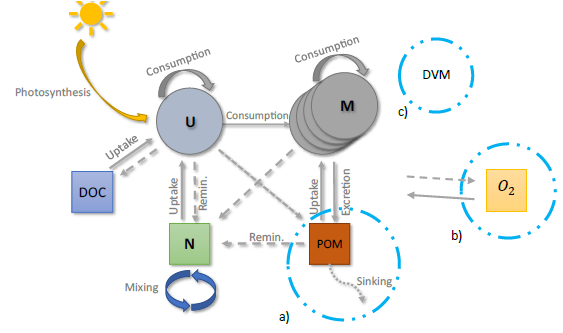
Quantifying squid contribution to food production and the marine biological pump in future a future ocean
Daniel Ottmann Riera, Post doc with Ken Haste Andersen (DTU Aqua),supported by the Danish Science Foundation
2022-
I combine novel size- and trait-based modelling techniques with classic functional-group food-web concepts to make a sufficiently lightweight yet robust model of marine communities. Then, I validate the model predictions with empirical data. Core foci are to resolve both shelf and open ocean ecosystems and to represent emerging resources, in particular squid. Squid may be an underestimated driver of carbon export in the biological pump because they have a fast turnover rate, die after spawning, and their carcasses sink to the seafloor rapidly after dying. These characteristics increase carbon flux to the seafloor, where it can be sequestrated for long periods of time. The contribution of squid to the biological pump is likely becoming more relevant because their biomass is increasing globally. A key goal in my research is to quantify regional and global contributions of squid to the biological pump.
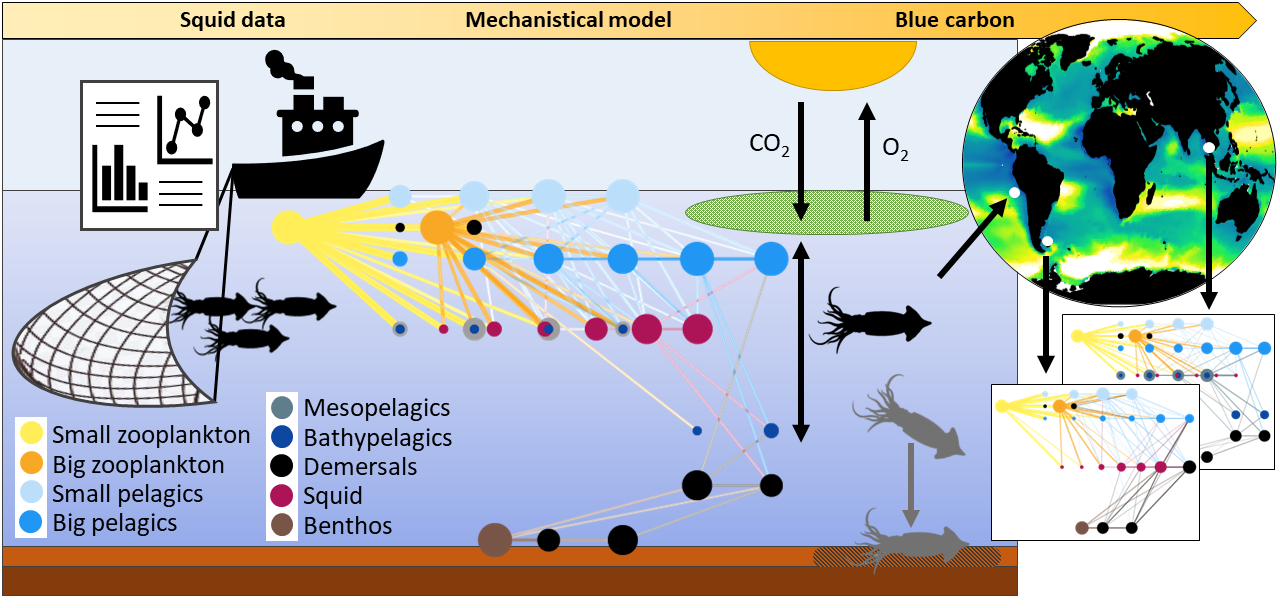
Trophic efficiency of the pelagic food chain
Amalia Papapostolou, PhD student, supervised by Ken Haste Andersen (DTU Aqua), Andy Visser (DTU Aqua) and Camila Serra-Pompei (MIT EAPS, USA)
2021-
The structure of the marine food web plays a crucial role for fisheries and ocean biogeochemistry. Food webs consist of interconnected food chains and in the ocean a food chain typically follows the sequence: phytoplankton, herbivorous zooplankton, carnivorous zoo-plankton, upper trophic levels (i.e. forage fish). It can take a varying number of steps within a food chain for energy to transfer from phytoplankton to fish across different oceanic regions, depending on the planktonic community composition. The length of the food chain is tightly linked to the concept of “trophic efficiency”, namely the efficiency with which energy flows from one trophic level to the next through predation.
The aim of my PhD is to make global estimates of the ‘microbial’ trophic efficiency from phytoplankton to small pelagic fish; basically how does energy flow across the food chain. This is crucial to improve our estimates and predictions for fisheries yields and carbon export. To do so, I will explore the mechanisms that govern marine food web dynamics through trait-based modeling, by implementing and further developing the “NUM” model framework, created at the Center for Ocean Life.
NUM is a mechanistic size- and trait-based model along the Nutrient-Unicellular-Multicellular axis, based on individual-level processes. In NUM, the multicellular component encompasses ontogeny and describes the population dynamics of key copepod groups, characterized by their adult size and feeding mode. The composition of the plankton community is an emergent property of the model, resulting from predation and competition. With this PhD, we expect to identify the main mechanisms linking higher trophic levels, such as fish, to primary producers.
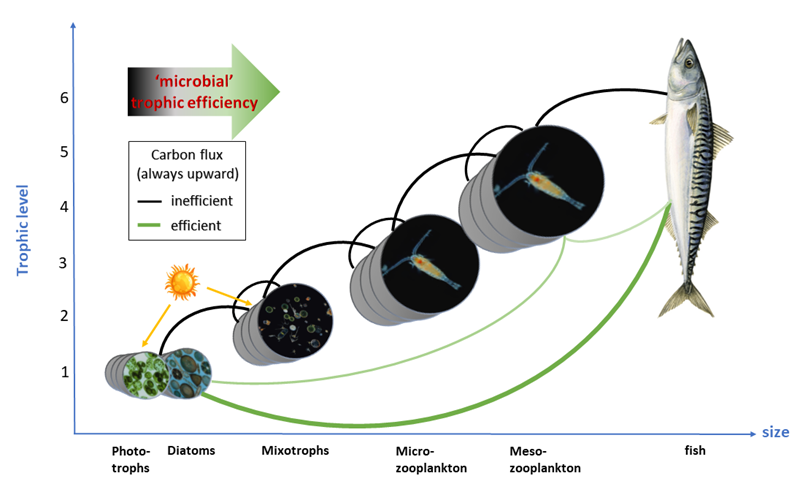
Fluid dynamics, ecology, and evolution of flagellate foraging
Federica Miano (PHYMOT Marie Skłodowska-Curie ITN), PhD student supervised by Thomas Kiørboe (DTU Aqua), Anders Peter Andersen (DTU Aqua) and Seyed Saeed Asadzadeh (DTU Aqua)
2021-
The evolutionary and ecological relevance of flagellates is increasingly being confirmed. They are found among all the branches of the eukaryotic tree of life, with highly diverse flagellar arrangements as well as resource acquisition modes that result from their diverse evolutionary history and origin. Also, they play a crucial role in the biogeochemical cycles of the global ocean due to their key position in the microbial food web: they feed on bacteria and other picoplankton, do photosynthetic activity, and are grazed by higher-level predators, such as zooplankton.
The simultaneous role as predators and prey, and their degree of success in eating without being eaten is key to understand the functioning of predatory flagellates. Their feeding activity dangerously exposes them to rheotactic predators that are sensitive to the flow disturbances generated by the flagellar motion. Therefore, flagellates have evolutionarily developed singular behaviours in terms of feeding modes and predator avoidance, to find an equilibrium between resource acquisition and predation risk. However, such trade-offs and how they are differently optimized by the different species are still largely unexplored.
During my PhD, I will study representative flagellates belonging to different branches of the eukaryotic tree of life. I will use a mechanistic approach to quantitatively describe the trade-offs between resource acquisition and predator avoidance and how these are constrained by the diverse flagellar arrangements, kinematics and beat patterns. The overarching aims of this project are to (i) understand the propulsion mechanism that triggers very fast escape jumps, (ii) characterize and quantify the fluid signal that elicit the escape responses, (iii) quantitatively investigate the kinematics and 3-dimensional beat patterns of diverse flagellar arrangements and use them as input to CFD models that can quantify foraging-predation risk trade-offs. These studies will be carried out using methods such as high-speed video recording, predator-prey co-culture incubation experiments, microfluidics, acoustic trap, and CFD modelling.
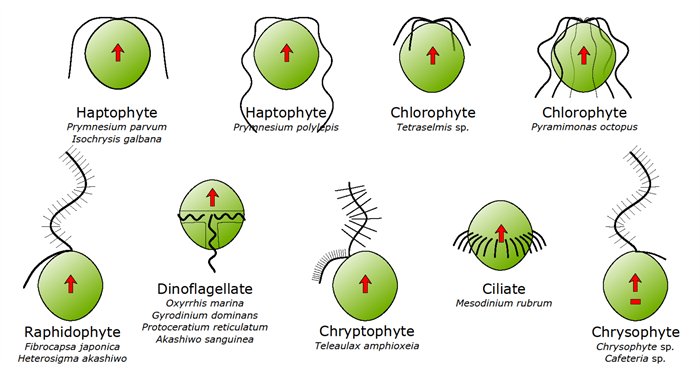
Nielsen, L.T. & Kiørboe, T. (2021). Foraging trade-offs, flagellar arrangements, and flow architecture of planktonic protists. Proc. Natl. Acad. Sci., 118, e200993011.
My PhD project is part of PHYMOT (Physics of Microbial Motility), an Innovative Training Network funded by Marie Skłodowska-Curie actions within the European Horizon 2020 Programme. The ITN consists of 15 PhD students from 8 countries. We will be trained in an interdisciplinary context at the interface between physics, biology, and engineering that aims at increasing our understanding of the physics of cell motility and at facing core challenges of the modern society such as food production, disease treatment strategies, sustainable and ecological development.
Trends and projections in invasive ecology: how susceptible to invasion are our marine ecosystems
Toni Vivó, PhD student, supervised by Martin Lindegren (DTU Aqua), Patrizio Mariani (DTU Aqua) and Cornelia Jaspers (DTU Aqua)
2021-
The spread of non-indigenous marine species has been increasing over the last decades, having a severe impact on native communities and ecosystem functioning. Studying invasions from a trait-based approach is really interesting to start addressing interactions between invaders and native species from -recipient communities, as the functional similarity between non-indigenous and native species coupled with the community assembly rules (environmentally or biologically filtered) play a major role on the invasion success.
The main goal of this project is to propose a trait-based framework to study and better understand how native and non-indigenous species interact and which consequences could these interactions have on recipient communities. First the functional dissimilarity between native and non-native organisms will be assessed, observing if the patterns of similarity are conditioned by the spatial scale, environmental or biotic conditions. For example, with really strong environmental gradients species tend to be more functionally similar, as they need to have a set of traits that allow them to thrive in a hard environment; within an invasion scenario, a greater similarity would mean stronger competitive interactions between natives and invaders. Following this trend, different areas and organism groups will be analyzed, to broaden the vision and see if the observed patterns are similar in other cases. Then, as functional similarity could influence the characteristics of recipient communities in an event of a newly species arrival, the potential consequences will be addressed for several communities; for example displacement of native species by other functionally similar organism, changes in ecosystem functionality or naturalization of the non-indigenous species.
Marine fish diversity patterns, drivers and underlying processes: present status and predictions under climate change
Marcel Montanyès Solé, PhD student, supervised by Martin Lindegren (DTU Aqua) and Ken Haste Andersen (DTU Aqua)
2021-
Marine ecosystems and the services they provide are nowadays threatened by several pressures such as climate change, overexploitation of species, habitat destruction, and invasion of alien species (Figure 1). These pressures are likely to negatively affect taxonomic and trait diversity of marine habitats. Failing to identify future biodiversity trends and thus, to tackle the necessary management and conservation actions, will most likely lead to important biodiversity losses. There is an urge to study biodiversity patterns and drivers to understand how they will be affected by climate change, so knowledge can be translated into effective management and conservation measures that seek to preserve biodiversity and hence, human well-being.
This project aims to study the effect of climate change and other human activities (e.g., fishing) on the past, present and future distribution, composition and diversity of marine fish communities throughout the North Atlantic and North-east Pacific oceans. To achieve this overall aim, there is a need to better understand the underlying responses of species to drivers and the key assembly processes (i.e., abiotic and biotic) shaping the taxonomic and functional (trait) structure and composition of communities at different spatio-temporal scales. We will therefore (i) study the effect and relative importance of assembly processes across areas and spatial scales, (ii) study climate change’s effect on the taxonomic and functional composition and diversity of marine fish communities and (iii) compare the spatial distribution of human activities and marine protected areas with fish biodiversity spatial patterns.
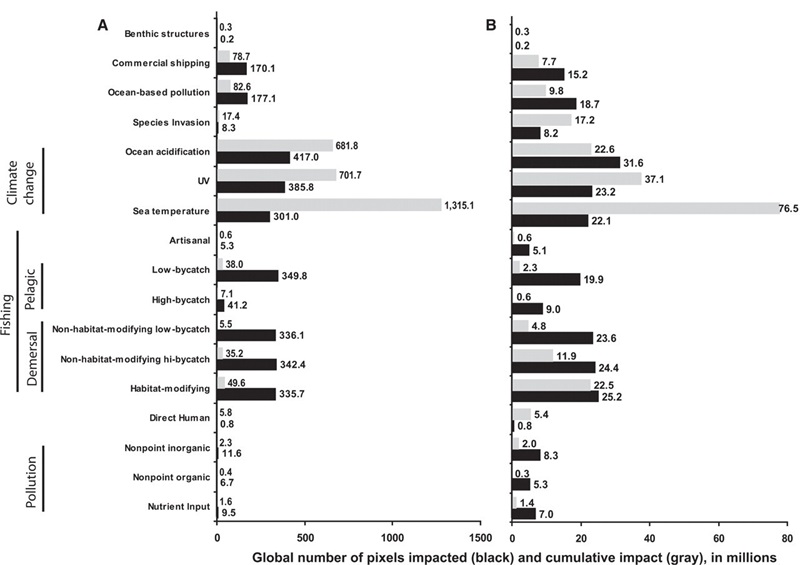
Figure 1. Total area affected (square kilometers, gray bars) and summed threat scores (rescaled units, black bars) for each anthropogenic driver (A) globally and (B) for all coastal regions <200 m in depth. Values for each bar are reported in millions.
Figure from: Halpern, B. S., Walbridge, S., Selkoe, K. A., Kappel, C. V., Micheli, F., D'Agrosa, C., ... & Watson, R. (2008). A global map of human impact on marine ecosystems. science, 319(5865), 948-952.
Global change and gelatinous zooplankton: Mechanisms and responses of jellyfish population dynamics to global change induced stressors
Magnus Heide Andreasen, PhD student, main supervisor Cornelia Jaspers, co-supervised by Mollie E. Brooks (DTU Aqua), Mark Payne (DTU Aqua) and Torkel G. Nielsen (DTU Aqua)
2020-
The project will investigate the ecology of gelatinous zooplankton (GZ), a diverse and largely disregarded group of marine organisms. Special attention will be devoted to predator-prey interactions with regional focus on the Baltic Sea. For the Baltic GZ comprise both well-known jellyfish species like the moon jelly (Aurelia aurita) and the lion’s mane (Cyanea capillata), but also pelagic tunicates (i.e., Appendicularia) and comb jellies (Ctenophora). Owing to their shared feeding niche with commercially important fish, e.g., cod, herring and sprat, their ecological response to global change is vital to understand. World-wide claims about increasing jellyfish populations exist but lack strong evidence and mechanistic understandings about their population control. Using long term population data of gelatinous zooplankton, physical and biological parameters, interactions between global change-induced stressors and jellyfish population dynamics will be addressed. Additionally, dedicated experiments will supplement field observations to gain a mechanistic understanding about observed interactions in the field. This PhD is financed by the Villum Young Investigator Program grant Gelatinous zooplankton: Overlooked player in marine food webs, favoured under global change? PI C. Jaspers (25512).
Gelatinous zooplankton: Overlooked player in marine food webs, favoured under global change?
Cornelia Jaspers, Villum Young Investigator Program grant (PI 25512)
Global change has manifold impacts on our world, especially on the oceans which cover >70% of the world's surface area. In the ocean, productivity is driven by microscopic primary producers, algae, which are consumed by small sized animals. These organisms are called plankton, as their own swimming ability does not allow them to fight ocean currents, making them passively dispersed in surface waters. Among those plankton organisms, animals which are transparent, gelatinous and soft bodies have largely lacked attention in the scientific community. They comprise members from different phyla in the animal tree of life ranging from jellyfish (cnidaria) and comb jellies (ctenophore) to pelagic tunicates (i.e. larvaceans) and span size ranges from several μm to several meters. While the public is aware about jellyfish and comb jelly blooms along beaches and in harbours due to their frequent blooms, those phenomena have seldom been included into systematic long term data acquisitions around the world (Brotz et al., 2012; Condon et al., 2013) and the apparent rise in jellyfish populations due to global change (Richardson et al., 2009) has repeatedly been questioned (Condon et al., 2012).
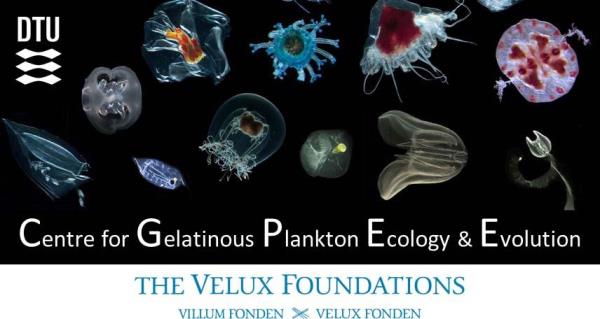
The centre for gelatinous zooplankton ecology & evolution will address the role of gelatinous zooplankton in marine ecosystems, question their apparent increase due to global change induced stressors, address their potential superior role as invasive species as well as fast adaptation potential to global change induced stressors by application of state of the art tools covering field based and laboratory experiments, ship board investigations and molecular tools. This knowledge will be essential to evaluate the role of gelatinous zooplankton in food web functioning from tropical to arctic ecosystems.
Application of next generation sequencing methods to address population origin, connectivity and range expansion of key gelatinous zooplankton species and their role in food web functioning
Jose Martin Pujolar, Post doc within Villum Young Investigator Program grant Gelatinous zooplankton: Overlooked player in marine food webs, favoured under global change? (25512 PI C. Jaspers)
2020-
The centre for gelatinous zooplankton ecology & evolution will address the role of gelatinous zooplankton in marine ecosystems, question their apparent increase due to global change induced stressors, address their potential superior role as invasive species as well as fast adaptation potential to global change induced stressors by application of state of the art tools covering field based and laboratory experiments, ship board investigations and molecular tools. This knowledge will be essential to evaluate the role of gelatinous zooplankton in food web functioning from tropical to arctic ecosystems. This post doc project aims to address diverse questions in gelatinous zooplankton research from a molecular basis including demographic history reconstruction of different marine invasive species, determination of population origin of different sub-populations and application of molecular tools for food web investigations to elucidate the role of gelatinous zooplankton in energy flow to higher trophic levels.
Behavioral games and emergent population dynamics
Jacob Emil Friis Frølich, PhD student supervised by Uffe H. Thygesen (DTU Compute) and Ken H. Andersen (DTU Aqua)
2019-
Why the big bad wolf went hungry
If the story of the three little pigs were to happen in the world of theoretical ecology, it would go something like: Three little pigs went out to forage after building their houses. The big bad wolf arrives. The three little pigs keep foraging and proceed to be eaten. Apart from being a slightly less exciting story, we know that it does not correspond to reality. In reality, the behavior of both prey and predators is dynamic, dependant on the environment, the presence of the counterpart and their opponents foraging behavior. Most population models in marine ecology do not take this into account, and instead assume constant behavior. In the real world, the behavior of both prey and predators is dynamic, depending on many variables such as the environment, the presence and foraging behavior of their counterpart.
For instance, the interaction between predator and prey can be modeled as a time-varying game, with the predators trying to eat as much prey as possible to optimize their own numbers and prey like-wise trying to maximize their own numbers while avoiding being eaten. At every instant each population observes the behavior and numbers of the other population, potentially with noise, and attempts to modify its own behavior to optimize the overall reward. Assuming that fish change their behavior depending on environment will hopefully lead to more realistic models, which might for instance be able to explain the phenomenon that when a cod appears herring stop eating and try to hide.
Expanding our understanding in this fashion is of huge importance, since we use ecological models as an integral part of our society, applying them to govern fisheries quotas and nature management. With a better understanding of population dynamics governed by the principle of optimal behavior, we might be able to manage our fisheries better and prevent fish stock collapses.
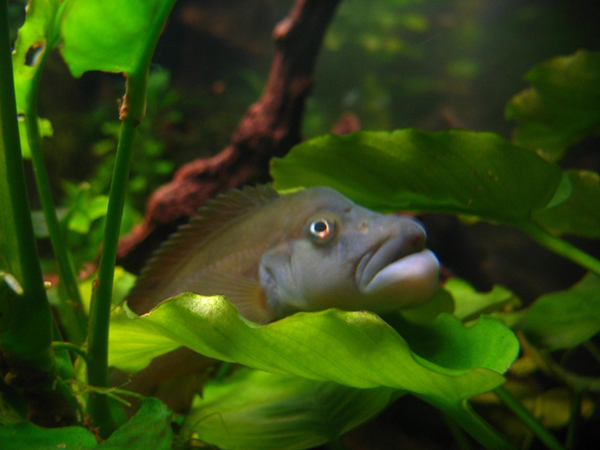
Photo: "Hiding" by Orin Zebest is licensed under CC BY 2.0, from
https://search.creativecommons.org/photos/2d4f7fc4-cc17-45c1-9128-374c828ed02e
Ecology and Fluid Dynamics of suspension feeders
Kristian Maar, PhD student supervised by Thomas Kiørboe (Centre for Ocean Life, DTU Aqua), Anders Andersen (DTU Aqua) and Uri Shavit (Israel Institute of Technology, Israel)
2019-
Suspension feeding is an ecologically important foraging strategy in the ocean and a diverse community spanning from microscopic unicellular organisms to the blue whale utilizes it to capture suspended food items from their aquatic environment. Marine suspension feeders face the challenge of successfully capturing adequate food to grow and reproduce in the ocean environment, which is a nutritionally dilute. The biomechanical solutions to filtering the water for food particles actively by generating flow with cilia or appendages are diverse and often highly efficient. In spite of the diversity and abundance of marine suspension feeders, many of the particle capture mechanisms are not fully understood.
My project focuses on understanding the fluid mechanics of marine suspension feeding and the impacts suspension feeding has on marine ecology. In the first part of my project I will use high speed video and particle image velocimetry (PIV) to understand the fluid mechanics of suspension feeding in acorn barnacles (Sessilia), and particularly how they are able to capture zooplankton with active avoidance adaptations. The formation and vertical transport of marine snow is an important aspect of the carbon pump and it facilitates the export of carbon to the deep sea. Marine snow is colonized by suspension feeding microorganisms that attach to the sinking snow particles and feed by generating flow with beating cilia. In the second part of my project will focus on the impact the colonization of microscopic suspension feeders has on the aggregation and sinking of marine snow.
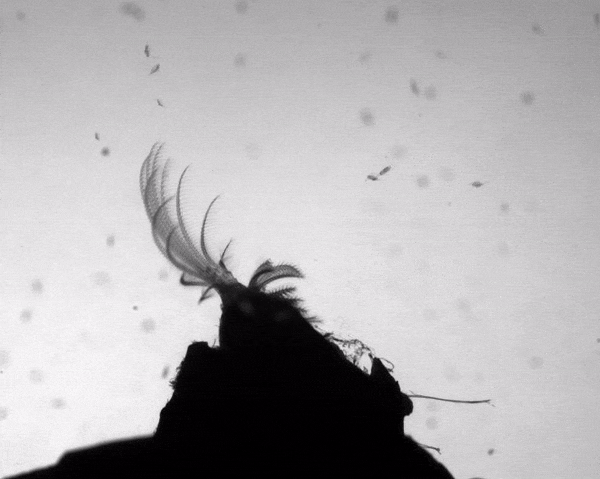
Figure 1 - High speed video of Balanus crenatus capturing a Acartia tonsa copepod.
Personality in Community Ecology Responses: Integrating the behaviour and species interactions of a marine invader
Nicholas Moran, Postdoctoral Fellow working with Jane W. Behrens (Section for Marine Living Resources, DTU Aqua) and Andre Visser (Centre for Ocean Life, DTU Aqua)
2019-22
In this project, I explore links between animal personality traits and diet, trophic position and body condition in animals. Personality (i.e. consistent among-individual differences in behaviour) is very common within species, and an animal’s personality type can change how it interacts with its environment, such as what it feeds on. Recent studies suggest that personality differences can alter the nature of trophic interactions between species and potentially contribute to ecosystem stability. Using both experimental and meta-analytic approaches, I investigate covariation between personality traits and feeding interactions.
Experiments focus on the personality traits and feeding interactions across the invasion front of the round goby (Neogobius melanostomus). The round goby is an invasive fish in the Baltic Sea and European inlet waters. By quantifying the degree that personality variability translates to functional diversity in feeding interactions, I will explore how personality influences the round goby’s impacts on invaded ecosystems. In addition, I use meta-analyses to synthesize the existing studies on the effect of personality in ecological interactions, with a specific focus on diet variation. Therefore, this work will combine community and behavioural experimental methodologies with meta-analytic techniques to explore the role of individual-level behaviour in marine communities.
instagram.com/nickmoran_pincer | twitter.com/nickmoranpincer
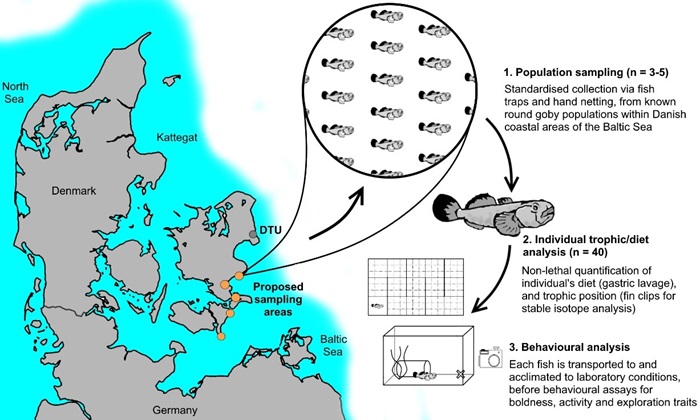
A global model for the vertical structure of fish
Rémy Denéchère, PhD student supervised by Ken Haste Andersen (Centre for Ocean Life, DTU Aqua) and Daniël van Denderen (Centre for Ocean Life, DTU Aqua)
2019-22
The aim of my PhD project is to develop a model capable of describing the vertical structure and the biomass of the fish community, and how it is shaped by two environmental variables: depth and primary production. This model rests on the trait-based approach, assuming that fish are split into functional groups with specific traits related to depth. The first part of this project is to develop a size-based model of benthos that can be included, in a second part, into a fish size-based model. Finally, the consequence of the vertical structure of fish will be assessed, in particular, the flux carbon from one to another group of fish and the impact of fishing on the whole ecosystem.
Indeed, the fish community is vertically structured and can be described as groups inhabiting layers in the water column, from the surface (pelagic group) to the seafloor (benthic group). The energy in marine ecosystems take place with phytoplankton and is spread into the ecosystem through two energy pathways, the pelagic (through trophic interactions) and the benthic (through sinking carbon particles) (see figure). The depth and primary production together determine the structure of the ecosystem that is the strength of interaction between fish groups and therefore its functions (biomass of each fish group and energy flux among the ecosystem). This vertical distribution of fish is expected to play a key role in the vertical flux of carbon in the oceans.
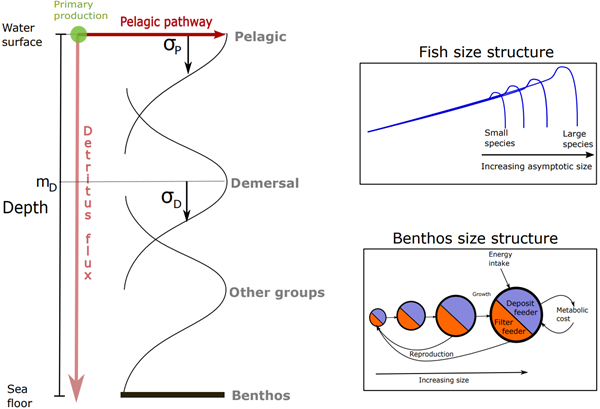
A trait based approach to the biological pump
Anton Vergod Almgren, PhD student supervised by Andy Visser (DTU Aqua) and co-supervisor Ken H. Andersen (DTU Aqua)
2019-22
The biological pump is the vertical transport of carbon, bound in organic matter through photosynthesis, from the surface ocean to the deep ocean. Together with the solubility pump (the transfer of atmospheric CO2 into the ocean) the biological pump play an important role in the global climate system, as it removes CO2 from the atmosphere and transport it to the deep ocean where it stays for hundreds or thousands of years. A major part of the vertical transport of carbon happens through the sinking of marine snow (particulate organic matter) and the fraction of the marine snow that is not re-mineralized before it reaches the sequestration depth (see figure) is buried in the deep ocean.
During my PhD project, I will develop a model that is able to describe the degradation and remineralization, as well as the aggregation, of marine snow particles. This will be put into a global context, using trait-based models from the centre to provide input in terms of particulate organic matter. The aim is to use this modelling approach for providing a realistic estimate of the efficiency of the biological pump on both global and regional scales. Further, the framework will also be available to evaluate the functioning of the biological pump in future climate scenarios.
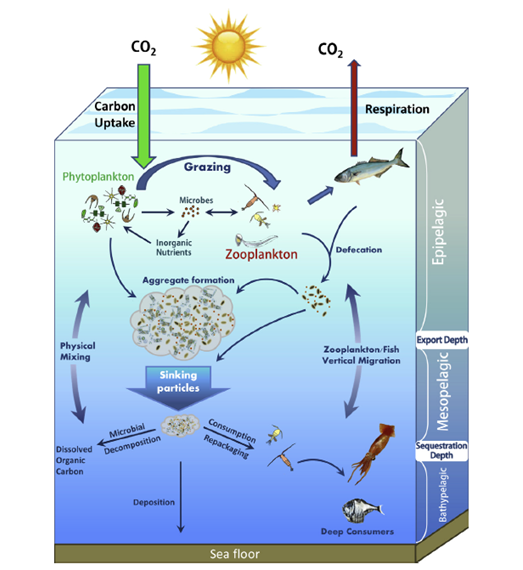
Figure 1: Schematic over the biological pump. CO2 is removed from the atmosphere and gets turned into organic carbon through photosynthesis by phytoplankton. The organic carbon is then transferred both through the food chain and by the sinking of organic particles. The sinking particles are partly remineralized and recycled back into the food web, and partly buried in the deep ocean.
Figure from: J. T. Turner, “Zooplankton fecal pellets, marine snow, phytodetritus and the ocean’s biological pump,” Prog. Oceanogr., vol. 130, pp. 205–248, 2015.
Analysis of migration dynamics using PDE approach to games
Maksim Mazuryn, PhD student supervised by Uffe Høgsbro Thygesen (DTU Compute), Mirza Karamehmedovic (DTU Compute) and Andre Visser (DTU Aqua)
2019-2023
How can a fish win in a game with infinitely many players?
To describe and study certain behavioral patterns of marine species one can rationalize the observed behaviour as strategies, where each member of the population tries to optimize its biological fitness, and construct corresponding game theoretical model. Classical game theory provides tools to analyse situations where players have conflicting interests, i.e. each player has a distinct payoff function and it depends on the decisions of all the players. Usually a strategy which results in the best outcome for everyone doesn’t exist and one can introduce various notions of an optimal profile of strategies, for example the Nash equilibrium, to capture different aspects of interest in the game. Another feature of classical game theory is that a player can affect the resulting gains for all the players by playing a different strategy. But what if the number of agents in a game is very large? Then analysis of the game is simplified by the fact that each player has insignificant influence on the overall evolution of the system. Such a game is called a mean field game and a theory of mean field games emerged from models in economics and finance.
The PhD project deals with diel vertical migration -- one of the largest daily movements of marine species where animals remain in deep, dark water in daylight hours to avoid visual predation and migrate to upper levels at dusk to feed. The migration of each organism can be rationalized as a trade-off between growth and survival with strategies as spatial distributions of populations. The idea of this project is to consider the diel vertical migration as a game each organism is playing against the others to maximize its biological fitness. Since the game involves large population of players, the aim is to develop mean field game framework to analyse and explain the migration process in terms of optimal strategies.
The dynamics driving vertical migration has broad implications for fluxes through the food-web predator-pray interactions; for fishery management to prevent fish stock collapses; for vertical transport of carbon from upper to deeper layers (i.e. the so-called "biological carbon pump") with implications for global climate study.
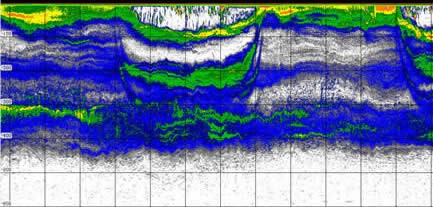
The picture has been downloaded from
http://www.acoustics.washington.edu/DEIMOS/deimos_data.php
Resilience and vulnerability of marine fish communities to change
Louise C. Flensborg, PhD student supervised by Martin Lindegren (DTU Aqua) and David Nogues Bravo (CMEC KU)
2019-2023
The world’s biodiversity is under threat from a broad range of natural and human pressures (e.g., overexploitation, habitat destruction and climate change) leading to a current rate of species loss 1000 times higher than the background extinction rate. The global decline in biodiversity and the function and services it provides for human wellbeing can therefore prove to be one of the greatest challenges that the world is facing today. Using species life history traits such as dispersal and generation length have been hypothesized to be important in determining the sensitivity of natural communities and species to climate change and human activity and their capacity to adapt to it. In particular, the loss of species with unique functional traits may have more severe consequences on ecosystem function compared to the loss of species with traits that are more common. The cross-scale resilience model provides a testable hypothesis for how resilience can emerge from species’ interactions with environmental structures and processes that vary with scale. It is based on the notion that resilience depend on the distribution and diversity of functional traits of species within and across spatiotemporal scales.
In this project, we will use available data on marine fish species abundances and traits to assess, quantify and compare the resilience and stability of marine fish communities across the North Atlantic and North East Pacific. This will enhance our current understanding of ecosystem resilience in marine fish communities by quantifying and mapping the extent of ecological resilience in marine fish communities across North Atlantic and North East Pacific, and by estimating how resilience control fish biomass over time. Furthermore, we hope to help guide future research and conservation effort by providing an assessment, and ranking, of the ability of current marine protected areas to protect fish communities of low resilience.

Hydrodynamic trade-offs of feeding and foraging at micro-scale
Seyed Saeed Asadzadeh, Postdoc working with Thomas Kiørboe (Centre for Ocean Life, DTU Aqua)
2019-
Microbial marine organisms play an important role in aquatic food web by recycling nutrients. In the small-scale world of microbial organisms, the Reynolds number, the ratio of inertia to viscous forces, is small, hence the inertia plays little role, and viscous forces are dominant and one of the key determining factors in the microbial fitness. In the lack of inertia, governing equations of flow are reversible, and due to this reversibility, reciprocal (repetitive up-and-down or back-and-forth) motions do not generate a net flow or propulsion. Instead, microorganisms feed and propel themselves using 'non-reciprocal' deformations of their body parts. Examples are ciliary beat with a power and return strokes, flagella beat as a directional propagating wave. Another consequence of a viscous dominant world is that the effect of moving boundaries (cell/appendages) travel far distances relative to the organisms' body length, increasing the predation risk. In this project, using detailed computational fluid dynamics (CFD), we investigate how different flagellar arrangements, beat patterns, and kinematics fulfill the requirements of the organisms to acquire resources, to be 'quite' (i.e., stealth behavior), and to swim (mainly in terms of energetics/power consumption).
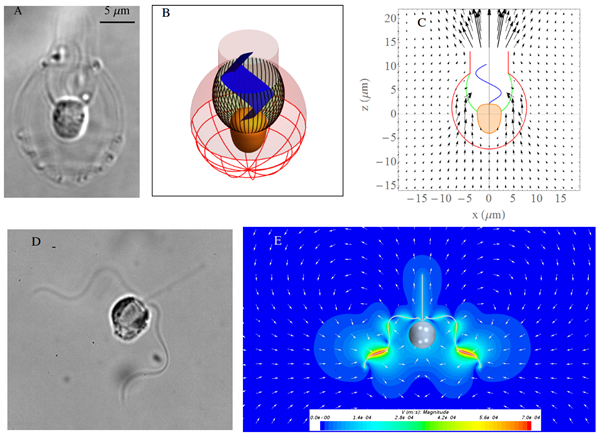
Example flagellates and CFD modeling:
A) Loricate choanoflagellate Diaphanoeca grandis, B) Model morphology of D. grandis used in CFD analysis, C) resultant flow field around the cell.
D) Prymnesium polylepis, E) CFD simulated flow field
Is trait co-variation key to predicting invasiveness of non-native fish?
Tommy Norin, Postdoctoral Fellow working with Thomas Kiørboe (Centre for Ocean Life, DTU Aqua) and Jane W. Behrens (Section for Marine Living Resources, DTU Aqua)
2018-
Invasive species are organisms that spread, most often human-mediated, from their native range into new environments where they become established and often cause tremendous ecological and economic damage. Their impact includes competition with native species for space, food, and survival, and the cost associated with damage and control of invasive species is approximately $7.7 billion annually in the USA alone. Eradication of invasive species has proven nearly impossible, so understanding how they will impact the environment in the future relies on predictions of their spread; key to this is a multidisciplinary approach: we need to understand how the new environments they encounter will affect their physiology and behaviour, as changes to these fundamental organismal traits will determine their growth, survival, and reproductive success.
In my postdoctoral project, I am investigating if variation among individuals in key physiological (metabolic rate) and behavioural (e.g. activity, dispersal propensity) traits can improve our ability to predict how invasive species will spread into new environments. I am doing this by measuring these traits in individuals of the highly invasive fish – the round goby (Neogobius melanostomus) – under a range of salinities, and link variation in these traits to the fish’s performance. The round goby invasion front is currently in the brackish Baltic Sea and the biggest barrier for further spread into the oceanic North Sea is believed to be the higher salinity. Although some “superior” individuals may be able to withstand the higher salinity and continue invading, such elevated salinity tolerance may also reduce their performance due to negative effects on their physiology and behaviour. Investigating if such a trade-off exists is a key focus of my project. My results will also be used to build an ecosystem model predicting the spread and ecological impact of round goby.
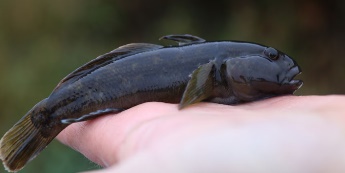
Round goby (Neogobius melanostomus). Photo: fiskepleje.dk
Physics of Microbial Feeding
Mads Rode, PhD student supervised by Anders Andersen (DTU Aqua) and Thomas Kiørboe (DTU Aqua)
2018-22
Unicellular micro-swimmers play a key role in the biological processes in the ocean. Through grazing on phytoplankton and bacteria, they have major impact on global biogeochemical cycles, and by being grazed, they transfer primary production to higher trophic levels. During the last three decades, only few studies have added knowledge to the pioneering work of Tom Fenchel that significantly progressed our understanding of the functional ecology of flagellated and ciliated micro-swimmers. Therefore, the key process of resource acquisition, i.e., how micro-swimmers capture their prey remains unexplored for most forms and the physical mechanisms by which micro-swimmers nevertheless clear huge volumes of water for prey are not fully understood.
In this project, I will examine the fluid dynamics of microbial feeding through direct observations of micro-swimmers with high-speed video-micrography, flow-visualisation techniques, experiments with dynamically scaled models and theoretical modelling. The focus will be on swimming kinematics, flow fields, prey capture mechanisms, and filter circumvention for microbial filter feeders.
Furthermore, I will investigate the possibility to make a novel acoustic tweezers to tether individual micro-swimmers without influencing their behaviour or creating spurious flows. This may increase efficiency performing experimental observations of micro-swimmers, which today take a disproportionate amount of time.
The project is supported by the Danish Council for Independent Research through research grant (7014-00033B).
Predation in a Microbial World
Sei Suzuki, PhD student supervised by Thomas Kiørboe (DTU Aqua) and Anders Peter Andersen (DTU Aqua)
2018-
Unicellular flagellated protists play a key role in oceanic biogeochemical cycles by feeding on phytoplankton and bacteria, while transferring primary production to higher trophic levels when being grazed upon. Despite of their key role in these biological processes, the mechanisms of flagellate feeding and how their resource acquisition trades off against mortality still remain widely unknown.
During my PhD, I will address the issue on how microbes ‘eat without being eaten’; i.e., (a) how they overcome the impeding effects of viscosity on prey encounter, and (b) how they can themselves avoid or reduce the chance of being eaten while they search for food. This dilemma materializes differently for different life forms, and is largely unresolved for small heterotrophic flagellates operating at low Reynolds numbers where viscosity dominates.
The overarching aims of this PhD project are to (i) describe and mechanistically understand prey encounter mechanisms in quantitatively important marine nanoflagellates, (ii) quantify their clearance rates, and (iii) asses the involved trade-offs, in particular the predation risk that is an unavoidable cost of feeding. These will be carried out using methods such as high-speed video recording, micro-particle image velocimetry (micro-PIV), predator-prey co-culture incubation experiments, among others.
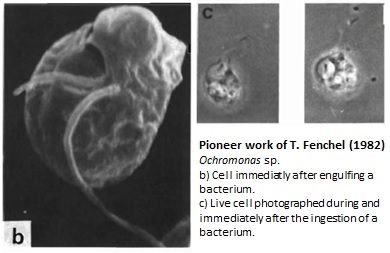
Defence in Diatoms: mechanisms and trade-offs
Josephine Bøgeskov Grønning, PhD student supervised by Thomas Kiørboe (DTU Aqua), Per Juel Hansen (KU), and Erik Selander (University of Gothenburg)
2018-22
Plankton organisms have evolved a multitude of defence mechanisms that reduce their risk of being consumed by a predator. Many eukaryotic unicellular plankton organisms have similarly evolved what is believed to be defence mechanisms. Examples include hard shells (e.g., diatoms, coccolithophores), colony formation, and toxin production, all believed to reduce predation mortality, but the trade-offs are often not documented, neither the benefits nor the costs, and even more rarely quantified. In fact, attempts to estimate defence costs have often shown these to be trivial, but costless defences are unlikely. Modelling experiments have demonstrated that the inclusion of defence mechanisms and the assumed shape of the trade-off function both have major implications to the diversity and function of plankton communities
My PhD project explores defence mechanisms and trade-offs in diatoms. Diatoms account for about ½ the primary production in the ocean and, thus, constitute an incredibly important group. They are characterized by all being purely autotrophic and by having a siliceous outer shell that is supposed to provide protection against grazing, although the direct experimental evidence is only now slowly being provided. The overarching aims of my project are to (a) provide a mechanistic description of how (and if) shell- and colony formation in diatoms provides protection, (b) quantify the costs and benefits of these assumed defence mechanisms, and (c) examine how the costs are paid (i.e., as a reduction in nutrient affinity (~competitive ability), as a change in resource allocation from growth to defence, or as elevated mortalities due to other grazers). Many presumed defence mechanisms are inducible; that is, they are only harnessed in response to the presence of grazers (or grazer signals, e.g., chemical cues), and that may apply also to both colony formation and shell thickening in diatoms. And the costs of a defence mechanism may only be significant if resources are limiting. Thus, an additional purpose is to (d) examine how the costs depend on environmental conditions, i.e., presence of grazers and availability of resources (nutrients, silica, light). Inducibility and resource dependency of the costs adds a further dimension to the trade-off function, and companion projects will through modelling explore the implications of this flexibility to the structure and function of plankton communities.
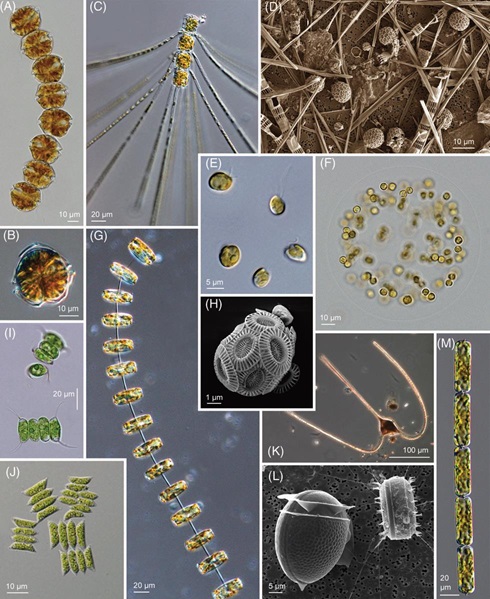
Pančić, M. and Kiørboe, T. (2018), Phytoplankton defence mechanisms: traits and trade‐offs. Biol Rev, 93: 1269-1303. doi:10.1111/brv.12395
Cost of physiological defense mechanisms in marine dinoflagellates
Fredrik Ryderheim, PhD student supervised by Thomas Kiørboe (DTU Aqua), Ken H. Andersen (DTU Aqua), and Per Juel Hansen (KU)
2018-21
Studies dedicated to defense mechanisms in plankton have often focused on the benefits of the defense, but have rarely established associated costs. So far, many experimental assessments have often shown defense costs to be low or insignificant, however, there must be trade-offs. For defense mechanisms to be considered adaptive there must be associated costs; otherwise non-defended species or strains would be out competed and all species would be equally defended, which they are not. For toxin production to be considered advantageous, toxicity must be signaled to the grazer before ingestion. It has been theorized that dinoflagellates use bioluminescence as an aposematic warning to showcase this and bioluminescent but non-toxic dinoflagellates are thought to utilize the mechanism to mimic toxicity. My PhD will focus on: quantifying the cost and trade-offs associated with toxin production in marine dinoflagellates; determine costs and explore the relation between bioluminescence and toxicity in light of the hypothesis that it works as a warning signal and can act in mimicry; through modelling explore the implications of costly defenses and of the shape of the trade-off on the structure and function of phytoplankton communities.
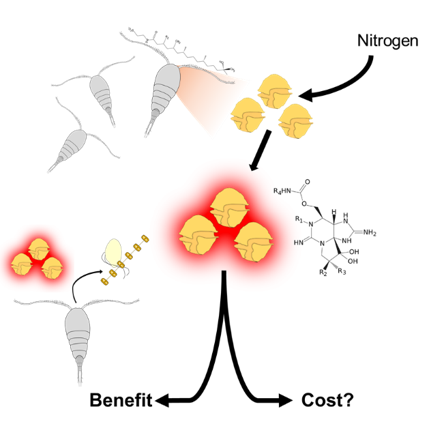
Hydrodynamic Tradeoffs: Feeding, swimming, hunting and hiding
Emily Riley, postdoc working with Thomas Kiørboe (DTU-Aqua)
2017-19
Focusing on the individual plankton level, there are many different traits that are important for fit, and therefore, successful organisms. Being able to feed effectively, evade predation, and swim to more nutrient or light rich environments are all important for an organism to thrive. At the microscale, organisms are constrained by their high drag fluid environment, and often rely on chemical and mechanical cues to sense prey or predators which are transmitted through the fluid environment. Thus the fitness of the organism is highly dependent on its hydrodynamics. This project aims to understand the different strategies employed by the staggering variety of microzooplankton to swim, feed and hide through observation and modelling of the fluid flows created. Using simple hydrodynamics models we aim to understand these trait tradeoffs. Furthermore, by employing a new experimental technique of acoustic tethering, we will be able to observe the fluid flows generated with greater accuracy.

Example flagellates: (a) Oxyrrhis marina (b) Prymnesium polylepis and (c) Prymnesium parvum, adapted from Jakobsen H. H., Everett, L. M. & Strom, S. L, Aquat. Microb. Ecol, 44, 197-206, 2006, with (d) Paraphysomonas vestita and (e) Monosiga sp. adapted from Fenchel, T., Adv. Microb. Ecol., 9, 35, 1982.
Mechanistic approach to plankton ecology: trait-based models of copepod communities
Camila Serra Pompei, PhD student supervised by Ken H. Andersen (DTU-Aqua) and André W. Visser (DTU Aqua)
2017-20
Copepods play a key role in shaping the marine plankton community by imposing a top-down control on the microbial system, and by partly regulating composition and abundance of planktivorous fish. Additionally, copepods largely contribute to the biological pump, enhancing carbon sequestration into the deep ocean. Yet the complex life cycle of this multicellular organism is often omitted in ecosystem models. The aim of this project is to develop a set of trait-based models of copepod populations and communities to better understand the observed seasonal succession and the environments that select overall copepod traits. As part of the project “Mechanistic Approach to Plankton Ecology”, the overarching aim is to embed this model of multicellular organisms into a larger model that includes the overall planktonic ecosystem ranging across several trophic levels. The model will be validated with data from the California Current, a system characterized by strong temporal variations and steep environmental gradients, being in many respects representative for other major upwelling systems supporting large fisheries of planktivorous fish.
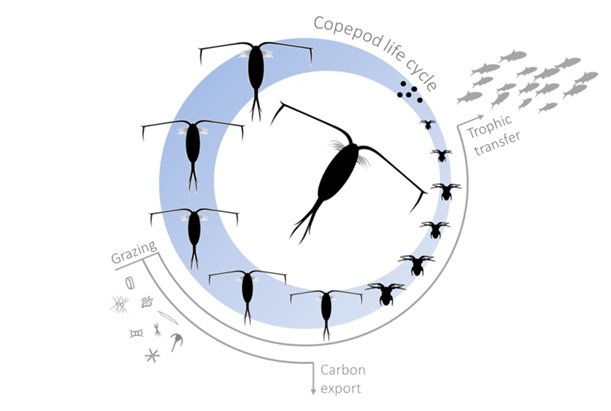
Vertical migration and the structure and function of pelagic ecosystems
Jérôme Pinti, PhD student supervised by André W. Visser (DTU Aqua), Patrizio Mariani (DTU Aqua) and Thomas Kiørboe (DTU-Aqua)
2017-20
Diel Vertical Migrations (DVM) is a common feature of life in the oceans, being exhibited by a wide range of organisms from marine mammals to fish and plankton. Grazers migrate to a certain depth during daytime to avoid visual predation, but have to return to the surface at night to feed on phytoplankton. This can trigger the same migration pattern for their predators, resulting in the largest animal movement on Earth in terms of biomass.
The migration of each organism can be rationalized as a trade-off between growth and survival, where each organism is playing against the others to optimize its fitness. Firstly, the goal of this PhD project is to use a trait-based approach to model these migrations which can be justified with notions from game theories such as Nash equilibrium. Secondly, once these migration patterns are understood, the consequences of DVMs for ecosystem functions will be assessed, in particular the trophic transfer efficiency of a food-web with organisms undertaking DVMs, and the role of DVMs in long-term carbon storage.
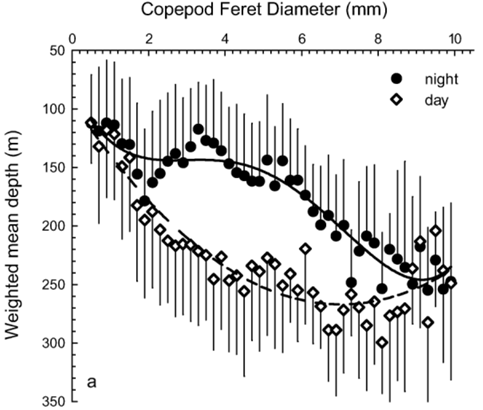
Migration depth and amplitude of copepods: a size-based approach (from Ohman and Romagnan 2016)
Mechanistic approach to plankton ecology: a trait-based model of the planktonic ecosystem applied to the California Current System
Mathilde Cadier, postdoc working with Thomas Kiørboe (DTU-Aqua), Ken H. Andersen (DTU-Aqua) and André W. Visser (DTU Aqua)
2017-19
Trait-based approaches have recently gained an increasing interest in both marine and terrestrial environmental sciences. In particular, they provide an insightful framework to improve our understanding of the complex relationships between marine planktonic organisms’ properties (morphological, physiological, behavior traits) and ocean biogeochemistry (e.g. primary production). Indeed, beyond its certain advantage in reducing the number of variables compared to taxonomic representations, modeling of traits enables a focus on the key processes explaining how functional diversity shapes food-webs interactions and ecosystem functioning. Using selected traits (size is often considering as a “master trait”) and trade-offs based on energy allocation, these models simulate emerging plankton community structure and associated functions according to environmental conditions (light, nutrient availability, food, predation landscape etc.).
My current research at the Center for Ocean Life takes place in the context of the “Mechanistic approach to Plankton Ecology Project”, which has as its main objective to develop a trait-based mechanistically underpinned, model of marine plankton ecosystems ranging across multiple trophic levels from bacteria to zooplankton. For this purpose, we develop a unicellular model that includes size, resource acquisition (phototrophy, mixotrophy and phagotrophy) and defense against predation as the main traits and is coupled to a multicellular (zooplankton) model resolving life stages, nutrition mode (ambush vs. cruise feeding) and diurnal vertical migration. This model will be used to explore and predict the plankton composition and optimal strategies across environmental mesoscale gradients in the California Current System. In parallel, the deployment of the Zooglider, an autonomous vehicle developed at the Scripps Institution of Oceanography with high resolution sampling in the region of interest, will allow accurate comparisons of model predictions and observed plankton assemblages.This newly developed model will also be used to address relevant questions such as biological pump efficiency and carbon export to depth in various oceanic regimes.
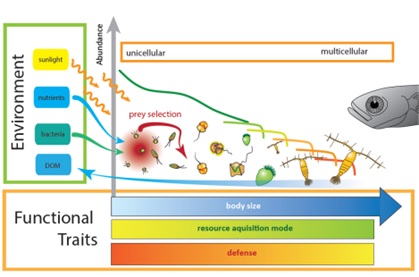
A trait-based approach to Biodiversity-Ecosystem Functioning in coral reef ecosystems
Neil Maginnis, PhD student supervised by Martin Lindegren (DTU Aqua)
2017-20
Species losses are causing changes to ecosystems in all regions of the world. Although the idea that species diversity supports ecosystem functioning is well established, the nature and drivers of the relationship are unclear. Failure to properly understand how diversity loss impacts ecosystems could have important ecological, social and economic consequences. In marine ecosystems, much of the existing evidence stems from small-scale experimental manipulations that fail to replicate the dynamics of natural ecosystems. These studies often point to the importance of particular species to supporting ecosystem function, though it may be that the actual driver is a certain trait of that species. Trait-based, observational approaches to studying Biodiversity-Ecosystem Functioning (BEF) relationships are therefore required to address the gaps in understanding that exist in this field.
Hard corals and the reef structures they construct are the basis of coral reef ecosystems. These are the most diverse marine ecosystems, supporting ¼ of all marine species. In this project I explore the relationship between the traits of hard corals and higher tropic levels. To do so I will determine the global distribution of coral traits and analyse how these covary with the traits of reef-associated fish and environmental conditions. Gaining knowledge of the influence of coral traits on fish communities will bring us closer to understanding BEF relationships in these ecosystems.
Understanding the biodiversity-ecosystem functioning relationship through large scale observations and modelling
Aurore Maureaud, PhD student supervised by Martin Lindegren (DTU Aqua) and Ken H. Andersen (DTU Aqua)
2017-20
The effects of changes in marine biodiversity on the ecosystems are still unknown and need further exploration, especially in the context of biodiversity loss threatening ecosystem integrity and services. The link between biodiversity and ecosystem functioning has been investigated in science for more than two decades. The biodiversity-ecosystem functioning (BEF) relationship has been largely tested experimentally, on enclosed ecosystems, on small parts of the food web, mainly on terrestrial ecosystems or using empirical data. Hence, there is a need in marine science to investigate the BEF relationship, using global observed data and modelling methods.
The aim of this project is to explore the shape and characteristics of the BEF relationship in marine ecosystems, using a broad range of metrics for biodiversity and functions. This project will use a comprehensive set of spatio-temporal data on marine species distributions, abundances and traits sampled across the food web structure as well as modelling and statistic tools. The established links can reveal the shape and nature of the BEF relationship and shed light on key ecological processes in marine food webs, such as trophic cascades, functional complementarity and ecosystem resilience. To create a global picture of marine ecosystems, the BEF relationships could be used to assess the impacts of fishing, natural environmental variability and climate change on the functioning of marine ecosystems. A better understanding of underlying patterns in marine communities could provide a new perspective on how environment and anthropogenic impacts drive the functioning.
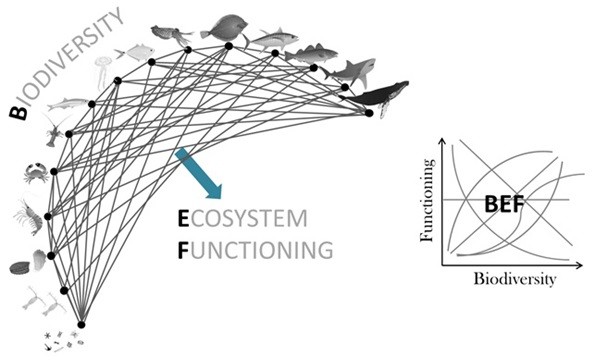
Understanding the role of biodiversity in community assembly - does functional diversity parallel species diversity across spatial scales?
Jeremiah Plass-Johnson post doc working with Martin Lindegren
2017-19
Recent work in ecology has used morphological, physiological and behavioural traits of species to better understand the composition, functioning and ecological responses, of communities to natural and anthropogenic changes, e.g., climate change and habitat degradation. In particular, such trait-based approaches have helped to characterise the functional composition of marine fish communities where global patterns in the distribution of diversity have long been a topic intriguing to ecologists. At this macroscale, fish species diversity and functional diversity decrease with distance from the Southeast Asia/Australia region because an increase in the number of species increases the range of traits present within a community. However, work assessing the relationship between these functional and taxonomic diversity indices has been equivocal because the degree of species sharing similar trait combinations differs between studies conducted at differing spatial scales. The lack of consistency between studies stems from differences in the relative abundance and aggregation of species at differing scales thus necessitating scale-independent metrics. This study, therefore, will assess the relationship between functional and species diversity of fish assemblages using multiple metrics to clarify functional diversity patterns across the globe. Because information on relative abundances and the trait composition of species is fundamental in determining these relationships, this study will utilise a unique set of spatially explicit, scientific survey data on global fish species distribution and abundance, as well as a comprehensive and publicly available trait data base for all marine fish species. The goal of this study is to account for changes in abundances and distributions of species and functions to create a mechanistic and generalised understanding of how species diversity contributes to functional diversity. By understanding this relationship, managers of natural systems will be able to make more informed decisions that conserve critical ecological functions and the ecosystem goods and services they provide.
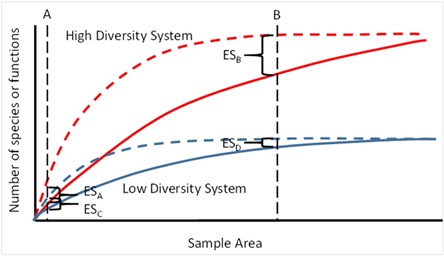
Marine Ecosystem Climate Services - Forecasting the marine biological environment
Anna Katharina Miesner, PhD student supervised by Mark R. Payne (DTU Aqua) and Brian MacKenzie (DTU Aqua)
2016-20
Tremendous advances in observing and modelling of the ocean that have occurred in recent decades: today it is possible to make accurate forecasts of physical oceanographic variables, such as temperature and salinity, several years into the future. However, the next step of converting these forecasts of the physical environment into forecasts of the biological environment, and therefore into variables that are directly relevant for stakeholders and society has yet to be taken. Developing these so-called “climate services” for marine ecosystems represents one of the new challenges in marine science.
During my PhD, I will develop seasonal-to-decadal scale forecasts of marine ecosystem variables for different marine species, such as blue whiting, based on the mechanistic understanding of the species-environment relationship. The aim of these forecasts is to enhance the species monitoring and facilitating its sustainable management. Accordingly, appropriate biological models relating physical and biological variables will be identified or developed and coupled to existing seasonal and decadal forecast systems and their forecast horizon and skill assessed.
However, there is no common protocol for estimating the skill of forecasts of the biological environment, yet. Therefore, building on the knowledge of forecast validation metrics used for example in meteorology and physical oceanography, I will review statistical tools relevant in assessing the quality of forecasts of biological variables important in fisheries science, such as the productivity (recruitment) or distribution of fish.
Copepod life cycles, population dynamics and trophic interactions in marine systems
Floor Soudijn, postdoc working with Thomas Kiørboe (DTU-Aqua) and Ken H. Andersen (DTU-Aqua)
2016-17
Small zooplanktivorous fish, or forage fish, support the largest fisheries in the world. At the same time, forage fish form an essential element of marine ecosystems as the main food source for large predatory fish, seabirds, and marine mammals. Forage fish are themselves supported by herbivorous copepods, the absolutely dominating group of marine zooplankton. However, it is unknown how copepod dynamics affect the flow of energy from primary producers to forage fish and thus, what drives global scale spatial and temporal patterns in forage fish production. This knowledge gap is a result of a dichotomy in marine science: research focuses either on biochemistry and plankton dynamics or on fish physiology and fish dynamics. Moreover, models of marine food webs typically contain a poor representation of copepods. Therefore, my project aims to predict global patterns in forage fish production by connecting fish and primary producers with the missing link: the population dynamics of copepods. I am planning to develop a phytoplankton-copepod-fish model that focuses on the copepod life cycle, based on a previously developed modeling framework for animals with complex life cycles. Using this model, I want to test the effect of copepod traits, seasonality, temperature and productivity on copepod dynamics and fish production.
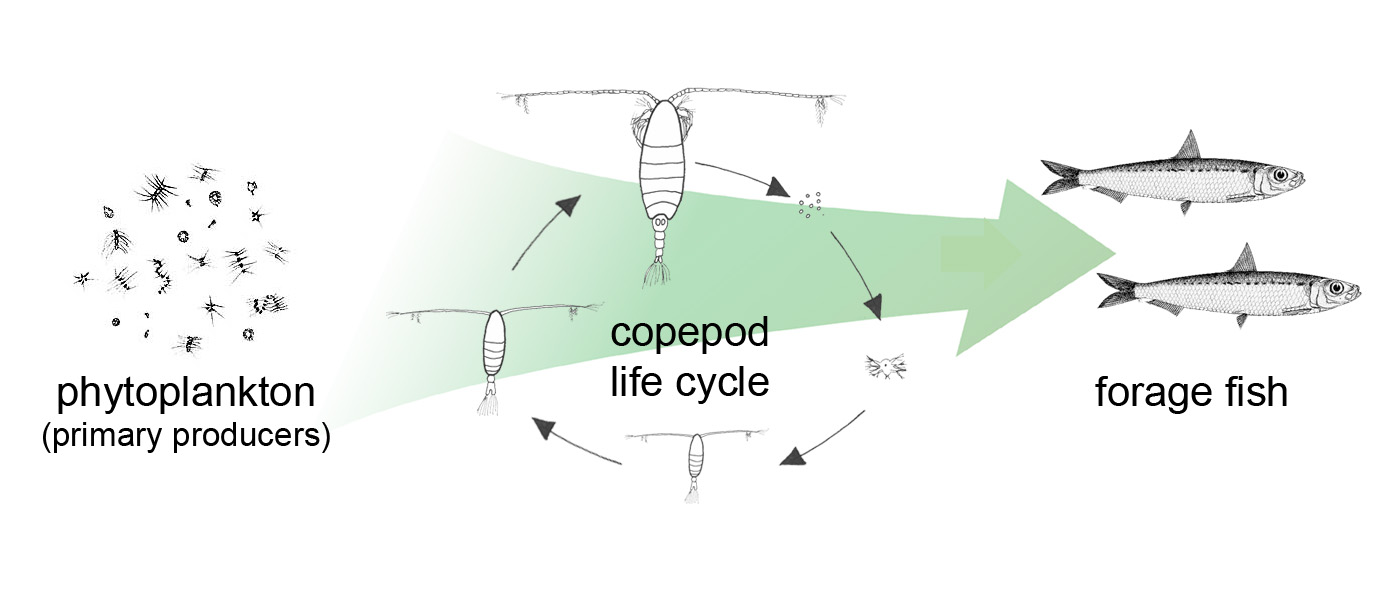
Characterization of factors determining the utilization of dissolved organic carbon by bacterioplankton in aquatic environments
Johanna Sjöstedt, postdoc working with Colin Stedmon (DTU Aqua)
2016-20
Climate change is predicted to result in increased precipitation and enhanced input of terrestrially derived dissolved organic carbon (DOC) to aquatic ecosystems in northern Europe. In aquatic systems one of the largest fluxes of carbon is from the pool of organic matter into microorganisms. However, despite a wide interest in assessing the regulating factors of dissolved organic matter (DOM) bioavailability, it is still to a large extent unknown what mechanisms that control the ability of microorganisms to utilize DOM. The aim of my project is to investigate which factors that are most important for organic matter degradation – diversity of the bacterial community or diversity of the organic compounds. Specifically I will 1) investigate if bacterial utilization of DOM is affected by the chemodiversity of DOM, taxonomic diversity or functional diversity of the bacterial community, 2) study if the functional composition of the bacterial community is defined from the environmental conditions, 3) investigate if threshold concentrations for utilization of DOM in the natural environment is affected by composition and diversity of the carbon sources.
A trait-based approach for predicting fish community structure, function and services under climate change and exploitation
Esther Beukhof (MARmaED Marie Skłodowska-Curie ITN), PhD student supervised by Martin Lindegren (DTU Aqua) and Ken H. Andersen (DTU Aqua)
2016-19
Marine ecosystems are exposed to both environmental and anthropogenic stressors, e.g. climate change and fishing, leading to concerns about the influence of such stressors on ecosystem processes, goods and services. Traditionally, fisheries management has focused on single species and populations. However, more emphasis is now put on developing management tools that can aid in assessing whole fish communities and their relation to ecosystem functioning. Trait-based approaches are a promising way to increase our understanding of fish community dynamics. Functional traits related to size, growth, diet and reproduction are believed to hold information on how organisms will impact ecosystems with regards to ecosystem functions, e.g. food web dynamics, productivity and fisheries yield.
My first research project will focus on the North Sea fish community. By using international survey data I will investigate the spatio-temporal patterns of several functional traits of fish to see how and if these trends are related to environmental and anthropogenic drivers. Once more understanding of trait distributions and their relation to the environment and fishing activities has been acquired, I will investigate spatial trait patterns on a larger scale to compare across large marine ecosystems worldwide. Because several traits are correlated their interactions on such a scale will be identified as well. Finally, I will use the knowledge gained so far to make predictions of the functional trait composition of fish communities under different scenarios of climate change and fishing, and how different compositions affects ecosystem functions and services.
My PhD project is one out of 15 projects that comprise the MARine Management and Ecosystem Dynamics under climate change (MARmaED) Innotive Training Network funded by the Marie Sklodowska-Curie actions. We will be trained in an interdisciplinary context that eventually aims at increasing our understanding of marine ecosystems and at creating new tools and insights that will enhance ecosystem-based management.
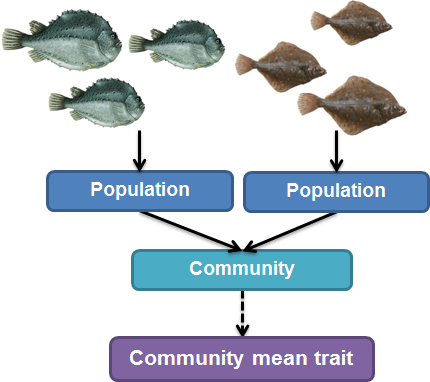
Density-dependent processes in marine fish stocks
Rob van Gemert (MARmaED Marie Skłodowska-Curie ITN), PhD student supervised by Ken H. Andersen (DTU Aqua) and Martin Lindegren (DTU Aqua)
2015-19
Density-dependent processes are important regulators of natural populations, including fish. All current theoretical and practical work on marine fish populations relies on the assumption that density-dependent processes occur early in life, before maturation and before fishing. This assumption may be correct, but it lacks a theoretical foundation and has only partly been subjected to empirical verification. I will be working on a critical assessment of the existing hypothesis of early density dependence as the central regulating process in marine fish populations. I will develop theoretical arguments for when in life density dependence occurs, seek existing empirical data to throw light upon density dependent processes, and examine what the implications are for current fisheries management and reference points. For this I will be working with a mix of theoretical modelling and analysis of existing data sets.
My PhD project is part of the MARmaED Training Network, an Innovative Training Network funded by the European Commission´s Marie Skłodowska-Curie actions, and consists of 15 PhD students from 8 research institutions. Through this interdisciplinary network of scientists, MARmaED aims to increase our understanding of the complex dynamics of seas and oceans under rapid environmental change and its socio-economic consequences.
Benthic-pelagic energy channels in marine ecosystems
Daniël van Denderen, postdoc working with Ken H. Andersen (DTU-Aqua)
2015-19
Marine ecosystem production is primarily supported by phytoplankton that forms the base of the pelagic food web and, after sinking to the bottom, may enter the benthic food web (often) as detritus. The contribution of both food webs to fish production may vary largely between ecosystems and will as such support different types of fisheries. In this project, we aim to assess the importance of the benthic-pelagic energy channel for fish production and fisheries catches in relation to different environmental drivers (e.g. changes in primary production, depth). The findings will afterwards be used in a food web model to examine how changes in the relative importance of the pelagic and benthic food web may affect the ecosystem response to fishing of different groups of fish (i.e. demersal, pelagic, demersal-pelagic). The model will describe the dynamics of a benthic and pelagic community and includes top-consumers that couple the communities by feeding on prey from both energy pathways.
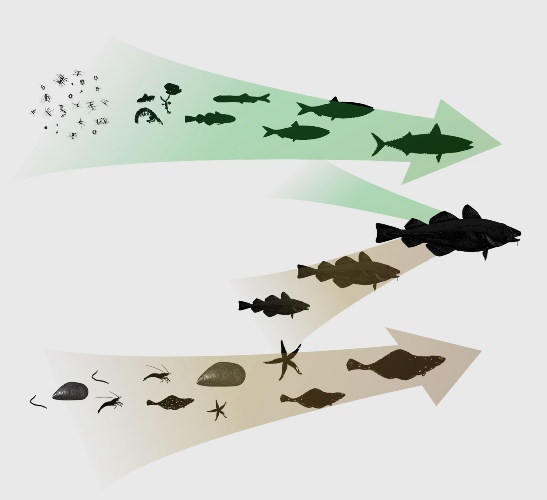
Benefits, cost, and tradeoffs of defense mechanisms in marine phytoplankton
Marina Pančić, PhD student supervised by Thomas Kiørboe (DTU Aqua) and André W. Visser (DTU Aqua)
2015-19
Phytoplankton is a highly diverse group of photosynthetic algae and cyanobacteria, which contributes to approximately 50% of the global CO2 fixation, and at the same time profoundly affects the biogeochemical cycles in the ocean due their requirements for various inorganic elements. The fact that many phytoplankton species coexist in the same space and at the same time on few resources, together with the strong top down selective pressure, demands for identification of the traits that determine their ecological niche. However, the competition-defense tradeoffs are very poorly described and quantified in phytoplankton, yet such tradeoffs are required – and, hence, arbitrarily assumed – in many models to allow the coexistence between many species of phytoplankton. In order to reduce predation from higher trophic levels, phytoplankton has developed a variety of physical and chemical defense mechanisms, and has additionally been found to be highly flexible in traits which affect their edibility. My PhD work aims at identifying and quantifying the tradeoffs of defense mechanisms, initially focusing on the thickness of the silica walls in diatoms, as this morphological trait is known to vary widely among diatom species. The fact that the thickness of the silica shells is a plastic trait and can be induced by the presence of herbivores, allows us to directly quantify associated benefits and cost to organisms by comparing induced and non-induced cells.

Functional diversity in fish communities in relation to ecosystem functioning
Tim Spaanheden Dencker, PhD-student, supervisors: Martin Lindegren (DTU Aqua), Mark Payne (DTU Aqua), and Peter Grønkjær (Aarhus University)
2015-19
Historically and traditionally, the concept of species has been used as a fundamental unit of biodiversity in understanding ecosystems functioning. However, intuitively, it is not the mere presence or absence of a species, but rather its functionality and interactions within a given ecosystems that determines its role and importance for ecosystem functioning, properties and processes. The functionality of each species in a community can be described through a range of traits, which in turn can be summed up as the functional diversity. Functional diversity has been recognised as a better predictor of ecosystems functioning, both scientifically, politically and in management and conservation. However, the concept is still very abstract and intangible compared to the more simple species diversity, and a series of fundamental challenges still exist within the field of research. My PhD project aims to close some of these gaps by investigating spatial and temporal patterns in functional diversity in marine fish communities on regional and global scales in relation to environmental factors and overall ecosystem functions, such as resilience, stability and productivity.
Plankton Trait Ecology in a Changing Marine Environments
Agnethe Nøhr Hansen, PhD student with main supervisor: André W. Visser (DTU Aqua)
2014-19
The spatiotemporal heterogeneity of the world’s oceans force marine life to specialize and develop traits that maximize their fitness in the specific habitat they live. In high latitudes the changing seasons influences light availability and turbulence conditions, and nutrient concentration alters as the blooming in spring depletes the nutrient pool. The expertise associated with the traits that increase the competitive ability in the habitat has a cost in the form of trade-offs, as an organism cannot be good at everything. I will set up a mechanistic model that describes how the traits of size, nutrient- and light-harvesting investments develop and distribute as a response to the changes experienced in a seasonal environment, and I will include the trade-offs that are associated with the traits. The model aims at increasing the ability to predict how phytoplankton communities will respond not only to the seasonal fluctuations in the environment but also the long term changes caused by climate change.
Hydrodynamics of small marine organisms
Julia Dölger, PhD-student supervised by Anders Andersen (DTU Physics), Thomas Kiørboe (DTU Aqua) and Tomas Bohr (DTU Physics)
2014-17
In my PhD project I will investigate marine zooplankton using fluid dynamic and kinematic principles related to their feeding and swimming behaviour and ecological models to investigate their fitness and competition. In particular I would like to understand the distinct gelatinous trait as compared to small carbon-dense body plans and the associated tradeoffs. Therefore I am trying to set up analytical models for gelatinous pelagic tunicates such as the centimeter sized filter feeding salps and compare their feeding efficiency and fitness to unicellular organisms such as choanoflagellates, which have a 100 times larger carbon density and are of much smaller size than the inflated salps. These very different organisms, however, are able to feed on similar submicrometer sized food and can thus compete with each other, whereas flagellates themselves are also part of the salps’ diet. As supplement to theoretical models I plan to measure the feeding currents and swimming dynamics of the modeled zooplankton experimentally using for example particle image velocimetry on living organisms.
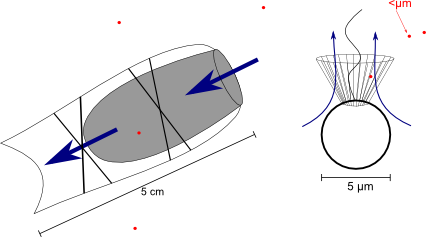
The sketch shows a salp (left) with large feeding net (grey), pumping water through its body by muscular contraction and a unicellular choanoflagellate (right), creating a feeding current through its filtering collar by the motion of its flagellum.
Trait-based approaches to phytoplankton communities
Subhendu Chakraborty, postdoc working with Ken H. Andersen (DTU Aqua)
2014-19
Trait-based models of phytoplankton communities have gained enormous interest in recent years. It has become an important tool to describe the evolution of large assemblages of species with aggregate group properties such as total biomass, mean trait, and trait variance (representing the functional diversity of the community). The size of an individual is considered as a key trait that characterizes its physiology and the feeding ecology. The main theme of my project is to understand how the size of an organism affects its food choice and provides competitive advantage to the organism in a specific environment. My approach is to consider individual-based models where the diversity in organisms is determined by their sizes.
Past and future changes in functional trait diversity
Anna Törnroos guest-Postdoc working with Martin Lindegren, Brian MacKenzie and Ken Haste Andersen
2014-18
A need to move beyond species richness in understanding patterns and changes of biodiversity has lead to the inclusion of functional diversity in ecological studies. Functional diversity refers to the range, degree and distribution of traits among species in communities and ecosystems. Utilizing multiple traits linked to specific ecosystem functions (such as production and biogeochemical cycling) has proven a successful method for assessing functioning over spatial scales. However, less is known about the temporal variability of functional diversity, which is particularly important if we are to predict future changes in ecosystems. Within this project past and future changes of functional structure and diversity under various environmental and anthropogenic drivers are studied on a community level. The aim is to extend these analyses to encompass multiple trophic levels and thus, focus on the major taxonomic and trophic groups (benthic invertebrates, fish, zoo- and phytoplankton). In this project, the Baltic Sea is used as a case study area, because of its natural environmental and diversity gradients, a well-known biology and ecological history as well as availability of long-term data series.
The project is part of the EU BONUS project BIO-C3 (Biodiversity changes – causes, consequences and management implications), and a close collaboration with Prof. Erik Bonsdorff (Åbo Akademi University) and research group.
Distribution of motile and non-motile phytoplankton across a shelf break and implications for optimal feeding mode of zooplankton
Kasia Kenitz, Postdoc, working with Ken Haste Andersen, Patrizio Mariani, Thomas Kiørboe and Andy Visser
2014-17
One of the fundamental traits characterising zooplankton populations is their feeding mode. The diverse modes can be distinguished into two types: ambush feeding that captures motile prey, and feeding current feeding that targets mostly non-motile prey. Distribution and abundance of motile and non-motile phytoplankton varies on temporal and spatial scales, reflecting the variability in the physical environment and nutrient availability. Seasonal succession from non-motile phytoplankton dominating the early spring blooms, to motile phytoplankton thriving during the summer stratification, reflects the environmental selection for efficient traits, where the ability of vertical migration is advantageous during the severe nutrient limitation in the upper ocean. On the spatial scales, distinct shifts in the phytoplankton community structure were observed across the continental shelf break. These shifts are associated with a region of strong vertical mixing of nutrients driven by the internal tide. Different types of food source and level of turbulence will modify the choice of zooplankton feeding strategy in order to optimize their fitness through balancing the efficiency of capturing prey and the risk of the predator encounter. The shelf sea environment provides a modelling framework used to investigate potential changes in the planktonic interactions in the regions of contrasting physical environment. The main objective of the project is to simulate the distribution of motile and non-motile phytoplankton across a shelf break and investigate how the choice of the optimal feeding mode of zooplankton changes from the open ocean to the shelf sea.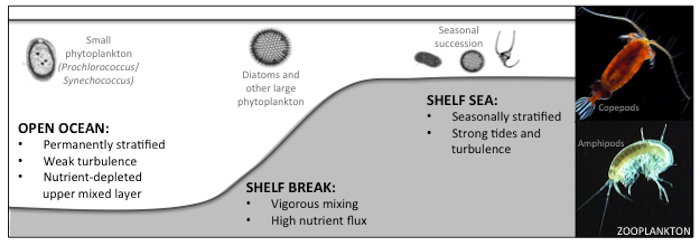
Diagram illustrating different physical regimes across a shelf break and examples of phytoplankton species that can be dominating in those environments during the summer.
Models for population dynamics in copepods
Sofia Piltz, Post doc, working with Ken Haste Andersen, Thomas Kiørboe, Patrizio Mariani and Andy Visser
2014-16
Traditionally, differential-equation models for population dynamics have considered organisms as ``fixed'' entities in terms of their behaviour and characteristics, and ignored the physiological changes (e.g., growth in size) during their lifetime. However, there have been many observations of adaptivity in organisms, both at the level of behaviour and as an evolutionary change of traits, in response to environmental conditions. In addition, while many organisms (e.g., ciliates) undergo small physiological changes during their lifetime, some organisms (e.g., copepods) grow through a succession of developmental stages (e.g., egg -> nauplius -> copepodite -> adult) that span over several orders of magnitude in size. Taking adaptiveness and individual growth into account alters the qualitative dynamics of traditional models and is an important factor to be included, for example, when developing reliable model predictions under changing environmental conditions. In this project, we use the mathematical framework of dynamical systems theory to construct models for predator-prey interaction. By carrying out mathematical and computational analyses of the resulting systems of equations, we aim to gain insight into the underlying mechanisms of plankton observations in the presence of adaptivity, growth in body size, ecological trade-offs, and seasonality.
Modelling the role of competition between fish and jellyfish in marine pelagic ecosystems
Nicolas Azaña Schnedler-Meyer, PhD student with main supervisor: Patrizio Mariani (DTU Aqua)
2014-17
In recent decades, reports of a supposed anthropogenic global increase in jellyfish abundances, and in the frequency and magnitude of blooms has been a subject of strong debate, reflecting a general lack of knowledge about jellyfish population dynamics and their role and significance in marine food webs. Though there has been an increase in our knowledge of the individual rates of jellyfish, the importance of jellyfish predation and competition impacts on ecosystem dynamics is still poorly understood, because jellyfish populations are hard to study in the field. The aim of this project is to investigate the importance of competition between jellyfish and fish for the dynamics of their populations, across different types of jellyfish and along different gradients of environmental conditions. I will work with mechanistic, trait-based population models, where population dynamics emerges from traits, processes and rates at the individual level.
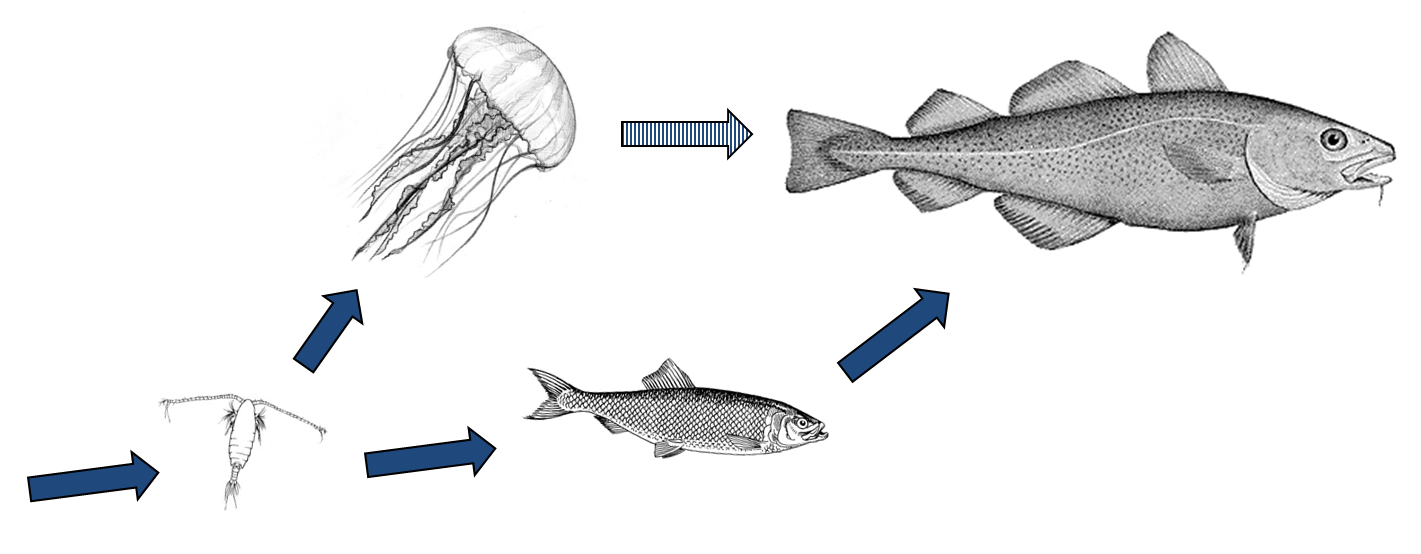
Simple food web containing fish and jellyfish, a copepod and a predatory fish. Copepod illustration from: Ohman, M.D., Drits, A.V., Clarke, M.E., and Plourde, S. (1998) Differential dormancy of co-occurring copepods. Deep-Sea Research II 45: 1709-1740. Cod illustration by H. L. Todd, from George Brown Goode, The Fisheries and Fishery Industry of the United States, (Washington, D.C.: Washington Government Printing Office, 1884), plate 58A.
Copepod gender differences in trade-offs between feeding, metabolic costs and survival
Hans van Someren Gréve, PhD student with main supervisor: Thomas Kiørboe (DTU Aqua)
2014-17
In order to understand the complexity of marine ecosystems and to generate predictive models recent research has focused on the investigation of fundamental traits and associated trade-offs. However, empirical evidence on the trade-offs associated with the three difference zooplankton feeding mechanisms is still scarce and has mainly focused on females. Like many other animals, the male copepod is typically focused on finding females in order to optimize its chance of reproduction. Therefore he has to sacrifice efficient feeding and increases the risk of predation. My PhD work aims at quantifying copepod trade-offs related to their gender, using representative copepod species for the main feeding mechanisms. I perform experimental work which focusses on the gender-specific feeding efficiency, metabolic expenses and predation risk. The results of this project will provide a gender specific quantification of trade-offs associated the main zooplankton feeding mechanisms and improve our current understanding of zooplankton mediated fluxes.
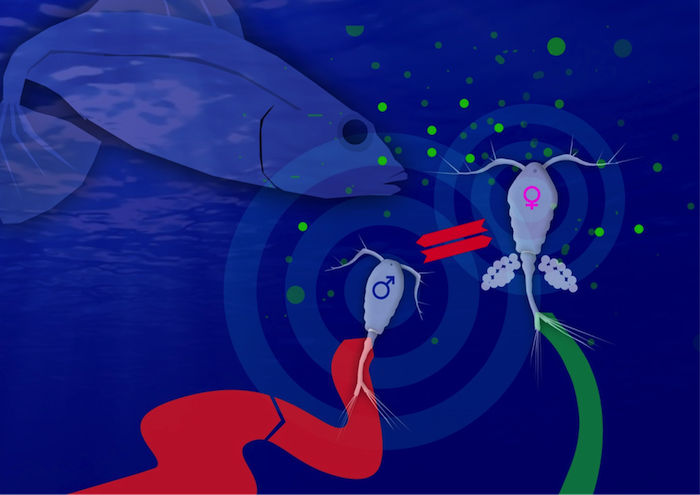
Traits and trade-offs in zooplankton behavior
Rodrigo Almeda, postdoc working with Thomas Kiørboe (DTU aqua)
2014-17
Knowledge of zooplankton predator-prey interactions is essential for better comprehension of the factors regulating the structure of marine food webs and therefore, for an integrated understanding of the marine ecosystems dynamics. Traditionally, models of pelagic marine food webs quantify interactions between species or functional types, but attempts to embrace the inherent complexity of marine food webs make these models very complex. An emerging alternative approach, the trait based approach, proposes to replace the thousands of species with organisms that are characterized by a few key traits (i.e. those characteristics/features that are essential to the success - fitness - of an organism) and their associated trade-offs (what are the costs and benefits of a particular trait). The present project aims to experimentally quantify the feeding tradeoffs (i.e., feeding efficiency vs. metabolic cost and mortality risk) associated with the three main feeding behaviors in zooplankton and to construct trait-based models to predict zooplankton trait distributions in the ocean. Overall, the proposed project will increase our ability to understand the factors that govern the structure and function of pelagic food webs, and predict their changes under different environmental conditions, including global climate change scenarios.
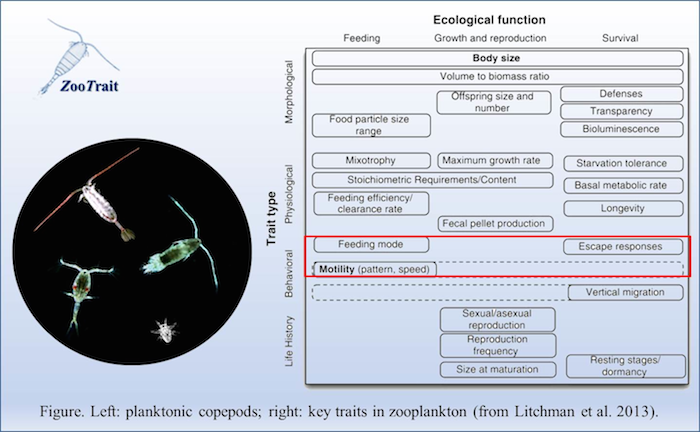
Functional trait diversity and the resilience of marine ecosystems
Martin Lindegren (DTU Aqua), Laurene Pecuchet (PhD student), Mark Payne (DTU Aqua), Ken H. Andersen (DTU Aqua)
Anthropogenic impacts, notably biodiversity loss, climate change and overexploitation, threaten the provision of ecosystem functioning and services worldwide. Therefore, maximizing resilience has emerged as a central tenet in ecosystem management. Although theory provides a conceptual basis for understanding the stabilizing role of biodiversity, its applicability to real ecosystems, especially marine areas encompassing complex biotic interactions, variable environmental conditions and vast spatio-temporal scales, is largely lacking. In this project, we aim to investigate the effect of marine biodiversity on ecosystem functioning by focusing on functional (trait-related) aspects of diversity on system resilience. The project will utilize modelling and observational data on marine fish traits and distribution to investigate large-scale biogeographic patterns of functional diversity and investigate and compare regional dynamics across ecosystems of various complexity and diversity, where long-term, high resolution data is available.
A trait based approach to explain the impact of climate change on plankton biogeography
Philipp Brun, PhD student with supervisors : Mark Payne (DTU Aqua) and Thomas Kiørboe (DTU Aqua)
2013-17
Plankton are ubiquitous in the world’s oceans and build the fundament of marine ecosystems. Through their high abundance and metabolic activity they also strongly affect global biogeochemical cycles and ultimately the climate system. Conversely, the alteration of the biogeography of planktonic organisms in response to climate change has been shown to be among the strongest across all forms of life. Knowing how plankton distributions continue to change in the coming century therefore becomes a challenge of high relevance. My PhD is set up around two key questions: Firstly, I will investigate how accurate future predictions of plankton distributions can be. I will use species distribution models to make projections across time and space and evaluate them with observational data from the past. This investigation will be done for many plankton species, as direction and magnitude of changes in biogeography show considerable species-wise variations. The second question is related to this versatility in distributional responses to climate change: I will try to explain the susceptibility to and direction of biogeographical changes based on characteristic traits of plankton, for instance size, dispersal ability, or mechanisms to avoid unsuitable conditions (e.g. vertical migration). This will be done by using an information theoretic approach and hierarchical statistical models. If changes in plankton biogeography could be explained by traits, we had a powerful approach to estimate changes for the large fraction of plankton species, for which observational data is very limited or not available at all.
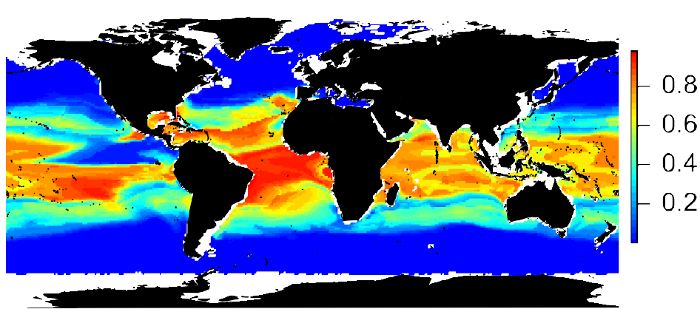
A trait-based approach towards a better understanding of benthic-pelagic pathways in marine ecosystems
Laurene Pecuchet, PhD student with supervisors Martin Lindegren (DTU Aqua), Mark Payne (DTU Aqua) and Ken H. Andersen (DTU Aqua)
2014-17
The energy flow through marine ecosystems may primarily be channelled through a pelagic- or a benthic pathway, or a combination of both. The degree to which marine ecosystems may support the pelagic- or benthic food chain and communities of pelagic or benthic fish has been shown to vary across natural and anthropogenic gradients in external conditions. This project will aim to investigate the two pelagic-benthic pathways, and to better understand their distribution along geographic (latitude, depth) or environmental (temperature, nutrients) gradients at the ecosystem and global scale along with the induced trade-offs (sensitivity to predation, food availability). The project will draw inference based on a wide variety of data, involving e.g., (i) synthesis of previously published studies; (ii) global data bases of occurrence and functional traits of zooplankton and fish and (iii) available scientific surveys of secondary consumers and fish. Furthermore, statistical relationships between key ecological traits and external variables will be investigated using several approaches, (e.g., meta-analysis and mixed linear (non-linear) modelling) in order to derive generic functional relationships valid across species or taxonomic groups. Phylogeny (evolutionary distances between the different species, or gender) could also be used to infer the traits distribution for data poor species and would permit to study the importance of functional diversity in the LME (Large Marine Ecosystem).
Consequences of fishing-induced selection of behavioural types
Lise Marty, Post Doc working with Ken Haste Andersen (DTU-Aqua)
2013-15
I am interested in the evolutionary effects of fishing in harvested fish populations. Rapid adaptive evolution in response to fishing-induced selective pressure (an elevated mortality often associated with size-selectivity) has been cited as the most plausible hypothesis to explain temporal trends in life-history traits revealed in time-series of phenotypic field data. These changes involve decrease in age and size at maturation, higher reproductive investment, and modification of juvenile growth rates, which together commonly leads to smaller adult size-at-age and can thereby impact stock recruitment due to the effect of body size on individual fecundity. In addition, some behavioural traits, such as activity level and boldness, may also increase an individual probability of capture. Fishing might therefore select against more active and bold individuals, which also tend to be faster-growing and have a higher mortality in presence of predators. This project studies the ecological conditions under which fisheries-induced selection of behaviour affects life-history trait evolution and population-level recruitment. Under natural conditions, differences in reproductive success of behavioural types (bold/shy) should mainly depend on food availability and the density of predators. I use a size- and trait-based approach, in which a stock is defined by its mean asymptotic body size, to model individual life-history and behaviour, and quantitative genetic principles to estimate the rate and direction of trait evolution.
Overwintering strategies of copepoda
Mark Wejlemann Holm, PhD student supervised by Benni Winding Hansen (RUC), André William Visser (DTU Aqua) and Torkel Gissel Nielsen (DTU Aqua)
2013-17
Copepods are the most numerous multi-cellular organism in the marine environment. Copepods are zooplankton and constitute a primary link between primary producers (phytoplankton) and higher trophic level (e.g. fish). During periods with adverse environmental conditions, in temperate regions during winter, copepods disappear partly or completely from the plankton. Copepods have developed different strategies to cope with winter conditions, these can be divided into three categories; dormancy, production of resting eggs, and winter activity. There is generally lack of understanding of which ecosystems that support these overwintering strategies worldwide. Therefore, the aim of my research is to determine how copepod species with similar overwintering strategies are distributed worldwide. Furthermore, I focus more specifically on species that display winter activity, and to what extent they are able to survive without food. Lastly I focus on the importance of resting eggs for early population dynamics in the beginning of the productive season. By gaining an understanding of what governs population dynamics of copepods, it is possible to develop models that can predict how food webs will be influenced by climatic changes.
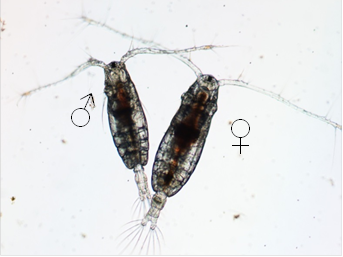
Quantifying physiological costs and benefits associated with the "mixotrophy trait" in plankton
Starrlight Augustine, post doc working with Terje Berje (KU), Per Juel Hansen (KU), Thomas Kiørboe (DTU Aqua) and Ken H. Andersen (DTU Aqua)
2013-15
The general philosophy is to conceptualize mixotrophy as a trait with values ranging from 1 (completely heterotrophic) to 0 (completely autotrophic). A-B represent micro-photographs of two individuals of Phacus who were both observed in same pool (pers. comm. Bas Kooijman 2011, Speuldersbos, The Netherlands). (A) shows an individual without chloroplasts and (B) an individual with chloroplasts. Thus in (A) we see a heterotroph and in (B) an individual who is at least partly autotrophic.This suggests that there are trade-offs associated with "choosing" between strategies. In order to investigate costs and benefits associated with the "mixotrophy trait" I will examine energetic costs associated with investing in cellular machinery involved in photosynthesis (e.g chloroplasts) and/or in heterotrophy (e.g. endocytosis). To this end I will parameterize a Dynamic Energy Budget (DEB ) model to mixotrophs ranging from completely heterotrophic to almost completely autotrophic. The way the DEB model conceptualizes the organization of mixotroph metabolism is illustrated in (C). The arrows represent energy/ mass fluxes and biomass is partitioned into reserve and structure. The light green line on the surface of the cell indicates the assimilation machinery. The way fluxes of different substrate are merged and then assimilated into reserve (grey arrows + red circles) must be idealized in such a manner as to capture the wide range of feeding strategies which occur in reality and so constitutes part of this project. My final aim is to investigate under which environmental conditions different degrees of mixotrophy can occur.
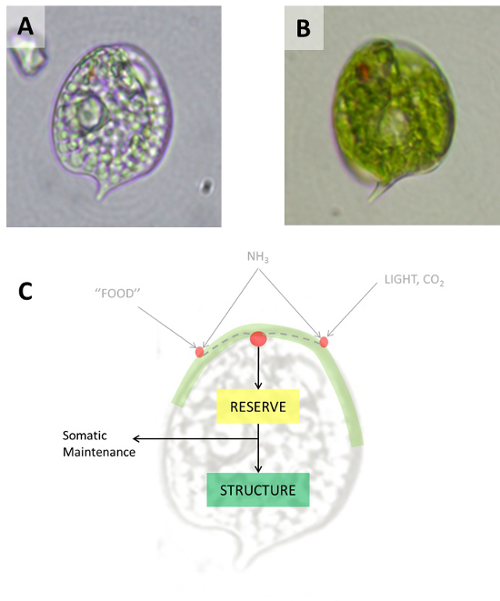
Zooplankton Fluid Dynamics
Navish Wadhwa, Ph.D. student supervised by Anders Andersen (DTU Physics), Tomas Bohr (DTU Physics) and Thomas Kiørboe (DTU Aqua)
2012-15
My PhD work aims at assessing the tradeoffs associated with feeding and swimming in zooplankton, e.g., copepods which are millimeter sized marine zooplankton. The idea is to combine experimental and modeling approaches to directly assess efficiency, energy expenditure and predation risk associated with the principal feeding and motility modes of zooplankton. We use particle image velocimetry (PIV) to describe flow patterns generated by freely swimming and feeding zooplankton organisms. Further we plan to use dynamically scaled models of zooplankton organisms to experimentally examine propulsion forces and spatial and temporal decay of flow structures under well controlled settings that are difficult to achieve with live zooplankton organisms. We use fluid dynamical models to estimate energetic costs and generalize experimental observations to other types of plankton than those observed. The result will be quantification of the tradeoffs associated with the principal modes of swimming and feeding in zooplankton.
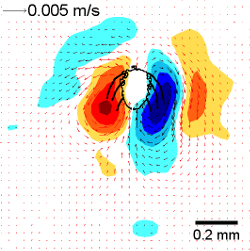
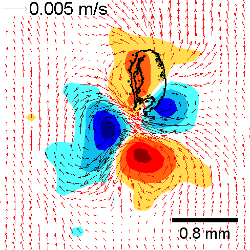
Bifurcation analysis of structured population models
Irene Heilmann, PhD-student with Supervisors Jens Starke (DTU Compute), Uffe H. Thygesen (DTU Aqua), and Mads Peter Sørensen (DTU Compute)
2012-17
My project is about structured population models and the mathematical solutions that can occur in these models. In structured population models we consider how the individuals in a population are distributed over values of a trait. In this context one of the most important traits for life forms in the ocean is the size of the individuals. When organisms grow from birth to maturation they can cover a large range of sizes and this gives rise to different interactions with the environment and within the population, e.g. smaller individuals will typically need less food. Structured models can exhibit various kinds of equilibriums and oscillating solutions and can also have multiple coexisting solutions. To systematically investigate how these solutions evolve and when new solutions arise as parameters are varied I employ numerical continuation methods that are based on the mathematical theory of bifurcation analysis.
Traits and trade-offs in microzooplankton grazing
Lasse Tor Nielsen, Post Doc working with Thomas Kiørboe (DTU Aqua), Anders Peter Andersen (DTU Physics) and Thomas Bohr (DTU Physics)
2013-17
My project aims to describe and understand various microzooplankton grazing techniques, and to quantify the advantages and trade-offs associated with each of them. Microzooplankton deploy various prey capture techniques, ranging from single cell predation using some form of ambush feeding, to filtering of water masses followed by collection and ingestion of the prey particles retained. With the former, prey cells are often almost as large as or even larger than the predator, whereas prey cells are typically one order of magnitude smaller than the predator in the latter. While filter feeding is often considered the most effective in a high food environment, it also comes with several trade-offs, including the larger energy expenditure and the elevated risk of predation due to the strong hydromechanical signals produced. The trade-offs will favor different feeding strategies under various environmental conditions. I work with several microzooplankton grazers, with various prey capture techniques, to describe and understand the mechanisms involved, as well as to quantify and parameterize the associated trade-offs. Videomicroscopy, hydrodynamically scaled models, particle tracking and modeling of flow fields are some of the methods that we apply in order to achieve this. Are ultimate aim is to improve our understanding of the spatial and temporal distributions of various feeding mechanisms found in the world's oceans - today and in the future.
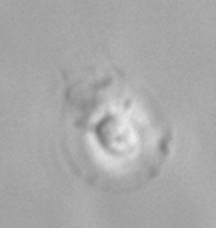
Traits for bacterial carbon turnover in the marine environment: chemical complexity meets bacterial diversity
Sachia Jo Traving, Ph.D. student at University of Copenhagen (KU) supervised by Lasse Riemann (KU) and Colin Stedmon (DTU Aqua). Collaborations with Uffe H. Thygesen (DTU Aqua)
2012-16
My research interests are focused on the marine bacterioplankton and their ability to degrade and take up dissolved organic matter (DOM). The DOM pool and nutrient conditions of an ecosystem are important factors for determining the function and role the bacterioplankton community exerts in the food web. In my project we focus on the function of the bacterial community, by investigating ectoenzymes, substrate utility and activity of the bacterial community and how this relates to the composition of the community and the characterizations of the DOM pool. The project is a mix of field and laboratory experiments and development of trait-based models on theoretical microbial questions. We deploy a range of techniques for these purposes such as characterization of DOM and microbiological and molecular tools for in depth investigations of the bacterial community
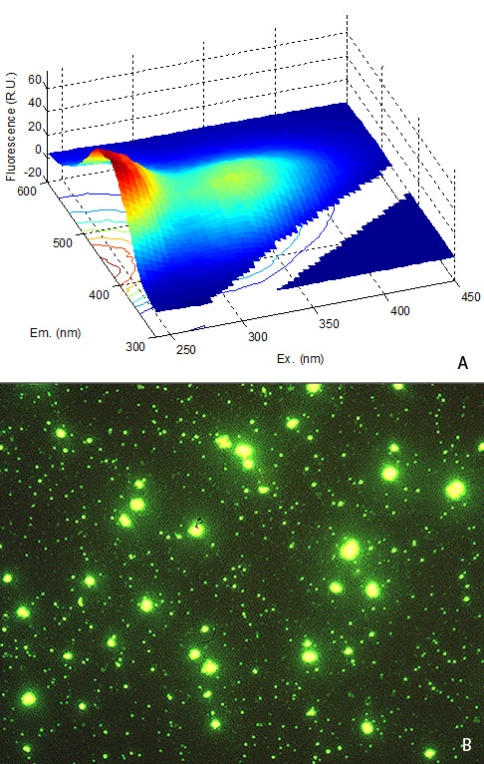
Figure A) 3D contour plot of an Excitation Emission Matrix (EEM) of the dissolved organic matter in a sea water sample (C. Stedmon). B) A sample of sea water containing bacteria and viruses stained with fluorescent DNA stain. Foto: L. Riemann.
Trait-based studies of mixotrophy in the marine plankton
Terje Berge, Post doc working with Per Juul Hansen (KU), Thomas Kiørboe (DTU Aqua) and Ken H. Andersen (DTU Aqua)
2012-14
My project combines laboratory experiments with trait based modelling to obtain a better understanding of why, when and where mixotrophy occurs in the ocean. Our traditional understanding of planktonic ecosystems involves a firm distinction between plant-like phytoplankton and animal-like zooplankton – the photosynthetic phytoplankton uses sunlight and inorganic nutrients to produce the biomass that is eaten by the heterotrophic zooplankton. This view is entrenched in textbooks and dominates mathematical modeling of ocean dynamics (NPZ-models). However, many zooplankton can actually also photosynthesize by the use of ingested chloroplasts, and many photosynthetic phytoplankton can feed on other organisms. The dual source of nutrition seems to provide these mixotrophs with a large competitive advantage relative to specialist phototrophs or heterotrophs. Nevertheless, specialists sometimes dominate ecosystems, indicating important trade-offs associated with mixotrophy.
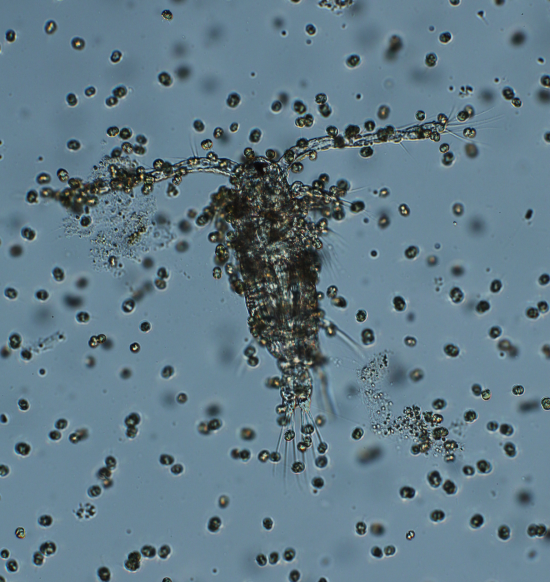
The image shows mixotrophic phytoplankton cells collectively feeding on a copepodite stage of Acartia tonsa (Berge et al. 2012, The ISME Journal 6)
Trait-based modeling as an ecosystem approach to fisheries management
Nis Sand Jacobsen, PhD student with supervisors Ken H. Andersen (DTU Aqua) and Henrik Gislason (DTU Aqua)
2012-15
My PhD project aims at quantifying direct and indirect effects of fisheries on fish communities. Fisheries management is moving towards ecosystem-based approaches in fisheries; all components of ecosystems must be taken into consideration when making an impact assessment. The project in particular focuses on interactions between fish, and the trophic consequences of harvesting certain components of the system. It is so far not clear which universal exploitation patterns are most beneficial in terms of: 1) maintaining original community structure, 2) achieving high yield or 3) maximizing economic revenue.
I use a size- and trait-based model to consider both the ecological and economical consequences of different exploitation patterns. The model rests on linking individual processes to the size of the fish, which is considered the most important trait in marine ecology. The linkage ignores the concept of species identity and instead describes a fish community by means of functional traits. The models now exist as a theoretical framework but are not operational as assessment tools in real ecosystems. I wish to develop this general approach to describe concrete ecosystems and examine long-term assessment plans and their indirect effects in global sustainable fishing.
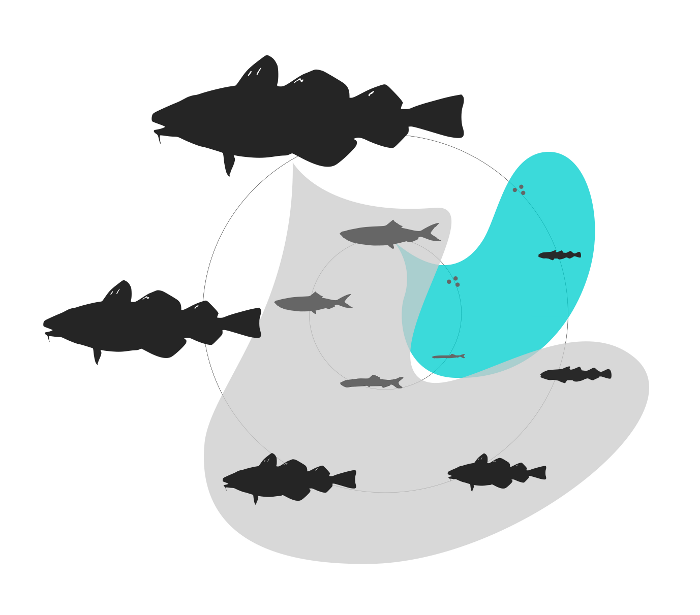
How copepods capture and ingest particles
Rodrigo J. Gonçalves, Post doc working with Thomas Kiørboe (DTU Aqua)
2012-14
I use a combination of experimental approaches to study the feeding behavior or a copepod (Temora longicornis) and its relation with the prey size. My aim is to understand the mechanistic underpinning for the feeding process to provide input to trait-based models. Understanding how zooplankton feed can be a challenging task, especially because it is difficult to observe with traditional methods. Some copepods for example move their mouthparts faster than any regular video camera can resolve. Therefore we use a high-speed camera to observe the very precise moment when the copepod detect, capture and ingest their prey. We combine this with bottle incubations and particle image velocimetry to gain a better insight of the feeding behavior related to prey/predator size relationships.
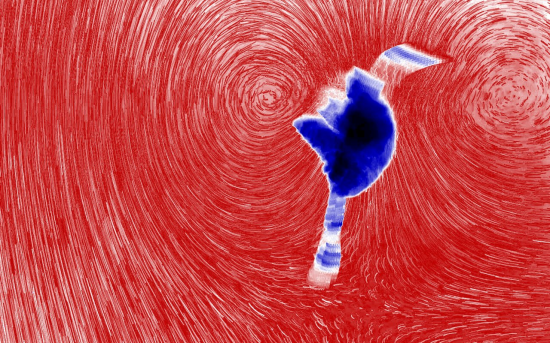
Reproductive traits of fish
Karin Olsson, PhD student with supervisors Henrik Gislason (DTU Aqua) and Ken H. Andersen (DTU Aqua)
2012-15
I investigate reproductive strategies in marine fish and how these strategies are related to environmental factors and physiological traits. Marine ecosystems are highly diverse and fish have adapted to life in a range of different habitats. Reproduction is central to this existence, and understanding which factors influence this, as well as how, is a fundamental aspect of management of marine ecosystems.
I collect data on important life history traits in a broad set marine species and try to identify what factors drive particular strategies. This approach takes into consideration both inherent traits of the species as well as external factors characteristic of the habitat and the ecosystem.
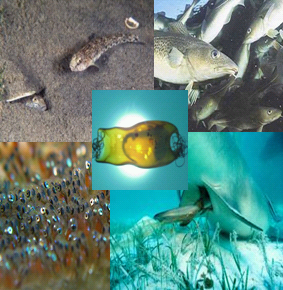
Chemical communication in the pelagic realm
Jan Heuschele, Post doc with Thomas Kiørboe and Erik Selander (DTU Aqua)
2012-14
My project focuses on the chemical characterisation of copepod sex pheromones and their usage pattern in different groups of copepods. Most organisms have the sensors necessary to perceive and use chemical cues of their environment. While for terrestrial organisms the trade-offs and mechanisms of chemical communication are fairly well known, knowledge about their use in the open ocean remains scarce. Males in several copepod species use female pheromone trails to find mating partners. This knowledge can be used refine the modelling of encounter rates, and thus the prediction of population growth in copepods. Besides mating partners, copepods also have to find food, for which they also seem to use chemical cues that are released from phytoplankton. We therefore also want to identify these feeding attractants, explore their use for copepod aquaculture, and their importance for copepod movement patterns. This project is also part of the IMPAQ project.
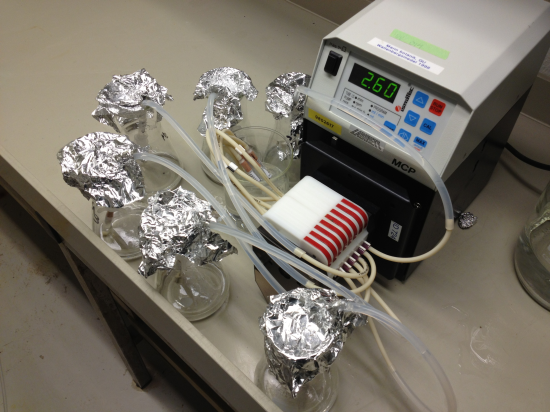
Trait-based modeling of trophic chains and seasonal forcing.
Erik Andreas Martens, Post doc. with Ken H. Andersen (DTU Aqua) and Thomas Kiørboe (DTU Aqua)
2012-14
My research aims at understanding how seasonality and its varying strength along different latitudes affects marine ecosystem structure: how does seasons affect predator-prey interactions in the ecosystem? How do seasonal variations influence overwintering and reproductive strategies of marine species? To answer these questions, I study mathematical models of the trophic chain in marine systems. Rather than employing the concept of species or functional groups, I use a trait-based approach, considering individuals with mechanistically based traits that are described by few parameters. By disposing of the species concept, the trait-based approach arrives at a succinct description with few basic parameters, and sidesteps the complexity trap of species-centric modeling approaches. Further my research advances trait-based methods by extending current models to include seasonal forcing and multiple trophic levels, and in particular to consider all the links ranging from plankton to fish. To obtain an integral understanding of the dynamics of marine ecosystems, it is crucial to include all trophic levels.
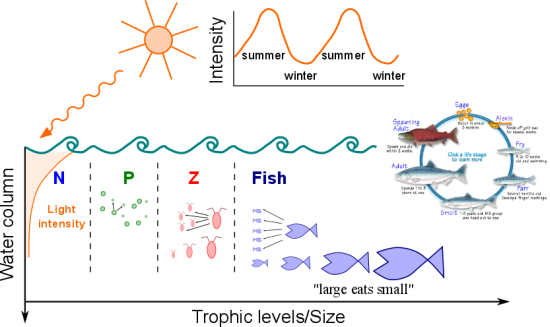
Reproductive traits of Arctic copepods
Julie Sainmont, Ph.D. student supervised by Andy Visser (DTU Aqua) and Ken H. Andersen (DTU Aqua)
2011-14
I model the life history of copepods with particular emphasis on the traits related to reproduction: size at maturation, spawning time, and whether or not to make reserves. I use an individual-based model to explore the consequences of these traits on specie's fitness as a function of the environmental conditions. I am inspired by the three Calanus copepods species that dominate the zooplankton community in the North Atlantic and the Arctic. The species have different reproduction traits (size at maturity and spawning time) to cope with the strong seasonality in food availability displayed in these regions. These traits consist of size at maturity and spawning time. Calanus finmarchicus, the smallest species, uses the incoming food to produce their egg (income spawner), while the biggest species, Calanus hyperboreus, stores reserves which fuel spawning when food availability may be low (capital spawner). The middle size species, Calanus glacialis performs a mixed reproduction strategy, storing some reserves but spawning also during the phytoplankton bloom.
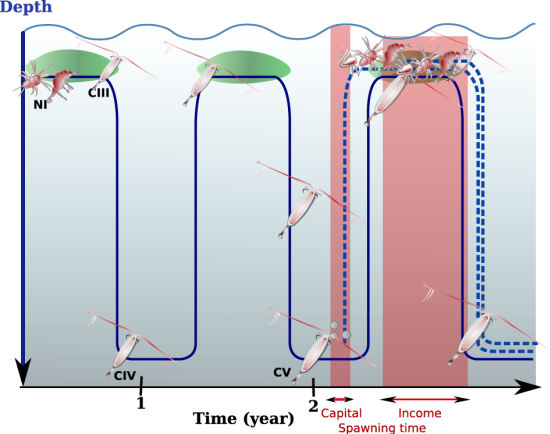
Global zooplankton trait distributions in an ocean ecosystem model
Friederike Prowe, Post doc working with Ken H. Andersen (DTU Aqua), Thomas Kiørboe (DTU Aqua), Andy W. Visser (DTU Aqua) and Mick Follows (MIT)
2012-14
I use a global ocean ecosystem model to simulate zooplankton communities characterized by two master traits: size and feeding strategy. The traits provide a mechanistic formulation of how zooplankton feed on both the phytoplankton and the zooplankton community based on predator-prey encounters. A changing physical environment, provided by the underlying ocean general circulation model, allows me to investigate biogeography, regional and seasonal differences in community structure and related ecosystem functions. The model generates theoretical predictions of the global distribution of plankton communities driven by our current understanding of traits and interactions. These can then be compared with the few observations available and may serve to assess the role of biology for ocean ecosystem functions and biogeochemical cycling.

</p